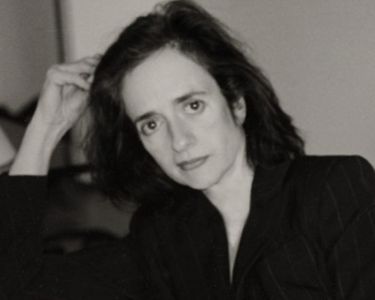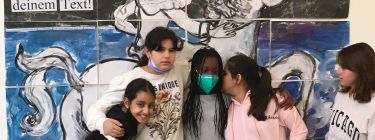
Curable Blindspot of Culture: How Participatory Arts Ignite Positive Change
Ira and Jewell Williams Professor of Romance Languages and Literatures and African & African American Studies at Harvard University and Director of Cultural Initiative at Harvard
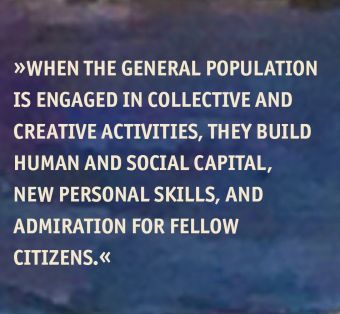
The Curable Blindspot of Culture: How Participatory Arts Ignite Positive Change
How Participatory Arts Ignite Positive Change
Culture is our necessary and renewable resource, the fourth pillar of sustainable development, though we often overlook it. The obstacle, in part, has been the word itself. Culture means two opposite things. One meaning is a heritage of shared beliefs, practices, and places, something to be protected rather than tampered with. This is the sense used by most decision-makers who are trained in the social sciences which privilege patterns over disruptions. The other sense is dynamic and familiar to artists and humanists who disrupt patterns and generate new relationships. One understanding is fixed, making culture either an obstacle to development or a fringe area for decoration and leisure, vulnerable to budget cuts. The other is edgy, experimental, and jealous of personal freedom. This difference in meaning causes a blind spot for both mayors and creatives who see past one another when collaborations are urgently needed to adjust outdated attitudes and behaviours that currently block development toward the SDGs.
Picture above: Copyright: Mannheim Public Library, Copyright Yilmaz Holtz Ersahin and Angelika Senft Rubarth
Today, in a post-pandemic world, we have an extraordinary opportunity to bring these visions together into bifocal projects. Shared beliefs and practices need to be refreshed and updated, as effective leaders know. The vast but under-acknowledged bank of evidence is witness to creativity’s power and potential. This includes a literature review by the WHO of 3,000 studies and an evidence base created by the EU and literally 100s of studies in specific cities. On the other hand, artistic interventions need to take stock of their practical effects, beyond personal satisfaction. Otherwise, we waste the creative resources that make us human. Collaborations will make us better citizens who can re-set our societies after the Covid 19 pandemic exposed habitual exclusions such as life and death inequities. Policies of inclusion in post-pandemic cities can count on participatory arts to foster collective belonging. Arts literacy projects will assimilate immigrants; and immigrant arts will enrich the local offer. (See www.pre-texts.org) The gains will be better security, physical and mental health, economic equity, and care in both senses of loving and taking responsibility for society. In sum, the power of arts as inclusion can energise cities across all dimensions.
The reason is clear. When the general population is engaged in collective and creative activities, they build human and social capital, new personal skills, and admiration for fellow citizens. Collaborations as well as supportive investments will harness the power of participatory arts, which is not the same as entertainment. Entertainment can be enjoyed passively, without engaging the energy of dynamic youth. Youth will build or ravage our cities; they actively participate in civic life or they reject it. And rejection can lead to violence, which simmers during lockdowns and has already exploded in many parts of the world. Our opportunity and obligation is to redirect youthful energy—we cannot extinguish it. Policing and punishment alone have not worked well, nor has single-minded investment in infrastructure. A few examples among many highlight the potential.
1. In 1995 newly elected Mayor Antanas Mockus of Bogota, Colombia faced a city mired in despair, violence and corruption. “Time to bring out the clowns,” counselled his Secretary of Culture. “Good idea,” responded the playful mayor. Twenty pantomime artists replaced twenty corrupt traffic police to shame irresponsible pedestrians and drivers. The shared laughter broke an apparently solid pattern of lawlessness. In the first year, there were 51% fewer traffic deaths. Many participatory arts initiatives followed, along with tax reform, transparency and infrastructural development. But art was the icebreaker. Within two administrations, homicides were reduced by almost 70%; tax revenues increased by 300%. This was “cultural acupuncture,” an approach developed from Jaime Lerner’s “urban acupuncture” for Curitiba, Brazil. Mockus added participatory art-making and accomplished astounding results.
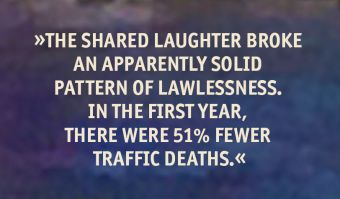
2. Edi Rama became World Mayor of the Year in 2004, mostly for painting the grey city of Tirana in bright colours. It did not solve all entrenched problems, but art did act as a catalyst to rediscover a pride of place and greater respect among citizens. An artist himself, Rama saw colour as more than decoration. It is a structural element to revive the civic spirit. “Beauty was acting like our guardsman… where municipal police, or the state itself, were missing.” This was his winning message in a campaign to become Prime Minister of Albania. Over the last few years, Tirana has made astonishing progress in its urban development, creating an urban forest belt of 2 million trees around the city core where children can plant a tree on their birthday. In 56 months, the city created 56 playgrounds in dilapidated parts of the city that act as gathering places and social connection points for all ages.
3. Broad-based music education has long proved to be a problem-solver, ever since El Sistema was established in Caracas over 50 years ago. By now, almost five million young people in Venezuela have benefitted from classical music training. It won’t make them all professional musicians, but it does teach discipline, focus,
collaboration, and dedication to beauty. Music-making, crucially, keeps vulnerable youth off dangerous streets. Many international projects have imitated this program with notable success.
4. This year Peter Kurz of Mannheim was awarded the World Mayor International Award. Much of his long-term work has involved using the arts to foster intercultural understanding and to regenerate troubled neighbourhoods such as Jungbusch. In Mannheim immigrants make up half of the population and former industries are giving way to new business models focused often on the creative economy. Sceptics about arts interventions sometimes object that they are not inspired, like Mockus, or trained as a painter, like Rama, or an engineer, like Lerner. Yet, Mayor Kurz is not himself an artist. Instead, his talent is to listen and to take small, cost-effective risks on art. One was his support for the School for Oriental Music, a unique initiative that a Turkish musician initiated to gather disaffected youth for rigorous time-consuming and community-building music lessons. This is one of many orchestrated ‘cultural acupuncture’ initiatives through which Mannheim addresses security and education by stimulating creative activities that foster diversity and belonging.
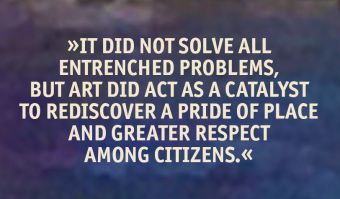
As part of a leader‘s toolbox, participatory arts can play a significant role in addressing the global challenges of SDGs. “Had I understood the power of arts to change behaviour and to drive prosperity, I would have made very different decisions as Minister of Development.” (José Molinas of Paraguay, formerly of The World Bank.) His change of perspective inspires a new “Certificate in Arts and Policy” for city governments in order to engage arts toward achieving a city’s goals, and to articulate particular goals with all the others. Each depends on the articulation: e.g. public health depends on education, transportation, violence prevention, etc. Education depends on public health, transportation, violence prevention, etc. The hybrid virtual and in-person sessions presents existing “Cases for Culture” and then customises co-constructions of new projects for the city’s challenges and resources. The Certificate complements the social science background of most leaders with humanistic thinking that recognises the arts as dynamic vehicles for developing human and social capital. (See https://renaissancenow-cai.org/wp/arts-and-policy/)
In a brief span of time, the Certificate in Arts and Policy consolidates deep European roots of democracy and development. Its people-centred approach can close the short circuit between high investments and low results, through cost-effective investments in art. Why does this work? A short answer is that the arts can include everyone. This means recognising art as the process of making, rather than products. Here participation and inclusion go together. This connection between participation and inclusion structures UNESCO’s broad-based program in arts education and entrepreneurship, “Towards 2030: Creativity Matters for Sustainable Development.”
Who is an artist and who an interpreter? Potentially all of us, to follow Friedrich Schiller who wrote Letters on the Aesthetic Education of Man in 1794. That was during the Terror of the French Revolution. Its shock value at the time was perhaps greater than our current pandemic and social upheavals. Slyly, he asks whether art may be an untimely topic for violent times. His affirmative answer is bold and compelling: Without art nothing changes. Humanity spirals into more violence, death, and despair.
Art is the name of development itself. It rejects inherited paradigms and it dares to experiment with new arrangements. If social science understands culture as a system of shared beliefs and practices, as Raymond Williams observed in Keywords, artists and humanists understand culture differently. It is confrontation with paradigms.
Schiller’s passionate call to action is to outsmart violence by breaking from habit and using frustration as a fuel to make something new, a surprise move, an unexpected creation that gives the maker a sense of autonomy and that stops the enemy in his tracks. This is trial and error—the way science works. And Schiller counts on our natural faculty to be creative. We have a drive to play, a Spieltrieb is his newly minted word. When we recognise the human condition as creative—which is evident precisely in under-resourced areas where people recycle and make-do—art is understood as a vital activity in which we all participate. Framing creativity as everyday resourcefulness to alter materials and relationships acknowledges the dignity of all people. Dignity follows from making because the artist is not a victim. Artists know that they have options and that they make decisions, even inside difficult constraints. This sense of autonomy and freedom within constraints is basic to citizenship. People feel proud of their creations and they respect beautiful things that others make. “Beauty was acting like a guardsman,” Mayor Edi Rama knew, “where municipal police, or the state itself, were missing.” He invited citizens to deliberate about colour and design to paint bright colours over old grey buildings. Even beautiful patrimonies of art, architecture, and monuments are there to be used. They offer historical continuity with precious urban spaces that link the past with the future. During the present COVID-19 restrictions on movement, digital programming has bought these sites of cultural heritage to an expanded virtual public.
Making autonomous choices through artistic practice channels the frustrations that many young people feel in our overcrowded and under-resourced neighbourhoods. Through art they can provoke and criticise in non-violent ways. “Symbolic violence” is another name for art and a pathway around the real thing.
Creativity is what distinguishes our species from other animals. Many are intelligent, but only human beings are imaginative beyond strategic thinking. Knowing this obliges us to create new things and new social arrangements. This is the theme that Josef Beuys made popular to repair the world after WWII when he established Documenta, the most important international art event, celebrated every five years in Kassel, Germany. As we speak, a stage of Documenta is being set for collaborations, because unlike previous editions, the 2022 event will promote community-oriented collectives. Artists have understood their urgent obligation to renovate creative practices and to adopt social and climate challenges. Today, artists, engineers, and educators offer initiatives to leaders who can recognise good bets and take necessary risks. This is the spirit of the early modern Renaissance. When the Medici bet on young Brunelleschi to build a monumental Cathedral dome, other investors scoffed at the folly. But the bet paid off, and the winners included the Medici, the artist and the entire city of Florence. In contemporary Italy, opera trucks are familiar interventions in immigrant neighbourhoods. Examples like these can help to ignite a new Renaissance Now with collaborations that take account of people’s creativity and that generate civic pleasure to keeps us engaged with each other as we face global challenges.
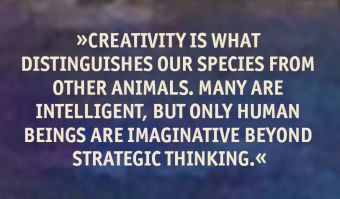
Doris Sommer
Doris Sommer is Ira and Jewell Williams Professor of Romance Languages and Literatures and of African and African American Studies at Harvard University. She directs the Cultural Agents Initiative at Harvard, and the Cultural Agents NGO dedicated to reviving the civic mission of the Humanities. Her projects include “Pre-Texts,” an arts-based training in literacy and citizenship, and Renaissance Now, a forum for rethinking culture in development. Her books include Foundational Fictions: The National Romances of Latin America (1991) about novels that helped to consolidate new republics; Proceed with Caution when Engaged by Minority Literature (1999) on a rhetoric of particularism; Bilingual Aesthetics: A New Sentimental Education (2004); and The Work of Art in the World: Civic Agency and Public Humanities (2014).Sommer’s work span’s Harvard’s Humanitarian & Cultural Initiative at the Mahindra Centre, the Executive Committee of the David Rockefeller Center for Latin American Studies, the American Studies Program, the Committee on Ethnicity, Migration, Rights (EMR); the Centre for Public Service and Engaged Scholarship & Global Health and Health Policy, South Asia Institute, and the Modern Language Association’s Working Group on K–16 Alliances. Recently, she prepared the Brief on Culture for the Summit of the Global Parliament of Mayors. Picture © Harvard Gazette
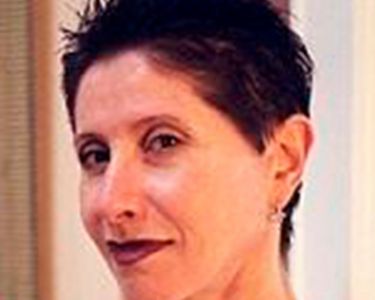
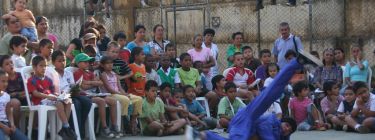
The cocktail of challenges of disadvantaged in crisis
Ruth Daniel, CEO of In Place of War and Honorary Research Fellow at University of Manchester; Teresa Ó Brádaigh Bean, Leader of research activities at In Place of War and Honorary Research Fellow at University of Manchester
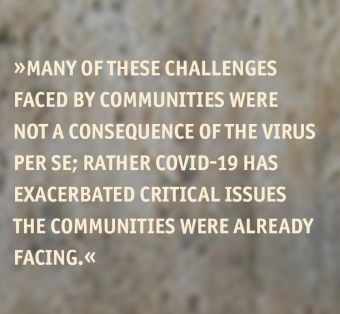
The cocktail of challenges of disadvantaged in crisis
Making the case for the civic role of the creative and cultural ecosystem in a Renaissance
The ongoing COVID-19 Pandemic has had a devastating impact on communities around the world. Whilst in Europe many have enjoyed the cushion of working from home or social protection mechanisms (special benefits and unemployment protection), disadvantaged communities in Latin America, Africa and the Middle East have been left vulnerable on all fronts. Operating in mainly the informal economy or in precarious employment, living in overcrowded housing, lacking access to information or PPE (personal protective equipment), and enduring some of the strictest and militarised lockdowns in the world presented these communities with a cocktail of challenges. This piece builds on the work of In Place of War in sites of conflict in the Global South for over 17 years working with grassroots arts-based peace-building as well as 120 cultural leaders and gives witness to the role of community arts organisations in civic engagement, using the arts to mobilise communities to make positive social change.
Picture above: break dance performance in a sports ground, Medellin, Colombia. Copyright: Leonardo Jimenez
COVID-19 was a further catalyst for community arts-based social mobilisation and civic engagement to tackle immediate issues of food insecurity, lack of sanitation, wellbeing, and public health awareness and school closures. Many of these challenges faced by communities were not a consequence of the virus per se; rather COVID-19 has exacerbated critical issues the communities were already facing. Working in partnership with our network of change-makers, drawing on their local knowledge, existing community relationships and understanding of how best to respond to the pandemic, we supported them in delivering direct, bespoke assistance, determined and led by those located in beneficiary communities. These locally-led processes resulted in a range of responses from the creation of community kitchens to mobile sound systems and online fundraisers and concerts to provide economic assistance to artists and the wider communities. Despite the array of projects, they all reaffirmed our understanding that art can be key in fomenting civic participation and positive societal change.
Despite or because of COVID-19: a new role for social enterprises
This process also demonstrated how, with a small amount of funding, informal, grassroots organis-tions rooted in communities that are often underrepresented in the cultural sector and who can’t normally access funding can lead to long-term positive outcomes. This included the development of sustainable social enterprises. Thus, this invites reflections in the European context and beyond about the importance of embedding participatory grant-making for grassroots arts organisations as a strategy to create a more inclusive and diverse creative ecosystem that supports arts-based sustainable development.
Hunger isn’t in Lockdown: COVID-19 in the Global South
As COVID spread, and lockdowns were imposed globally, our network of change-makers provided grim insights into the impact of COVID-19 on some of the world’s most disadvantaged communities. Here is a snapshot from artists and cultural practitioners on the ground in Latin America, Africa and Asia in April 2020.
MC Benny, Hip Hop artist, Northern Uganda: “People are living in fear, many are testifying that this is worse than a physical war. Our team has already seen that government forces have been using excessive force to enforce lockdowns”
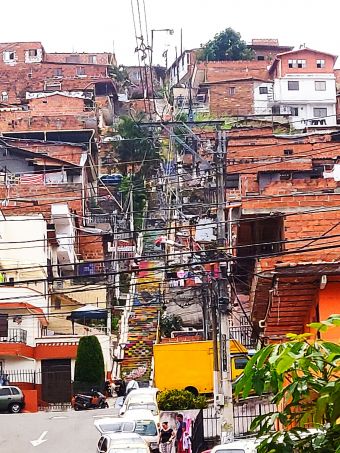
Nathalia Garcia, Elemento Illegal, Medellin, Colombia: “Communities in El Faro, an informal neighbourhood on the outskirts of Medellin where many displaced families forced to flee violence have been severely affected by COVID. The area is home to 400 vulnerable families living in dire conditions, working in informal and precariousemployment. Lockdown has left them unable to generate income and 98% of them are struggling to cover their basic needs with hunger being the most pressing issue. Preventing the spread of COVID in the area is further compounded by lack of basic sanitation and hygiene products.”
Vijay Kumar, India: “There is simply no support from the government, some families are on edge of starvation during these days.” Our team notes, “India has some of the most extremely high-density urban populations, social distancing is simply not an option for most of these people, and the consequences of lockdown are costing lives through hunger and lack of medicine.”
Robert Mukunu, Mau Mau Arts, Kenya: “A young boy was shot by police on the balcony of his home in Kiamaiko, Nairobi, because ‘he was out during the curfew’ which seems like a dark irony that a citizen was killed by police who were ensuring he was indoors to protect him from COVID. Questions still remain unanswered on why the government is charging for treatment of corona-related ailments as well as the use of testing kits and masks donated to the government.”
Re-birth in the midst of lock down? How to leverage support and funding from the Music Industry in crisis conditions
Whilst IPOW’s work has focused on supporting and building networks with grassroots artists in the Global South, the organisation has also developed relationships with commercial music industry partners. During the pandemic, given the devastating impact of COVID on the cultural sector, these organisations were keen to support artists and cultural practitioners. Thus, working in partnership with In Place of War, small grants of $500 to $2,000 were made available to the change-maker network.
Setting up an innovative process for participatory grant-making, locally informed decision-making and implementation.
A call for applications was sent to our change-maker network via Whatsapp in French, English and Spanish, resulting in 45 applications. The application process was open in which applicants had to explain the impact of COVID on their community and their ideas to address these issues. A small panel from the In Place of War Board and team reviewed applications, selected recipients, and funds were distributed promptly, having immediate impact. The overall process took only two weeks, including the due diligence process required to meet charity regulations. Given the geographical spread and diverse contexts in which artists operate, projects ranged from tackling food insecurity through the establishment of community kitchens, bakeries and allotments, public awareness campaigns about preventing the spread of COVID-19 using visual arts, and issuing grants to artists.
Change-Maker case studies
Delhi, India
Vijay Maitri is a theatre practitioner from the Kathputli Colony in Delhi, India.
Due to lockdown, this community of 12,000 performing artists (the lowest caste in India, considered to be the criminal caste) who live in slum conditions, were unable to earn money and therefore unable to afford any food or access PPE.
Vijay organised a food and PPE distribution centre in the neighbourhood and using the IPOW grant distributed food and PPE to 12,000 people.
Picture right: Vijay organising food distributions, Copyright: Vijay Kumar
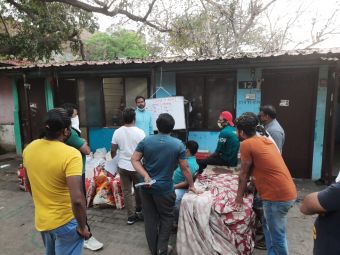
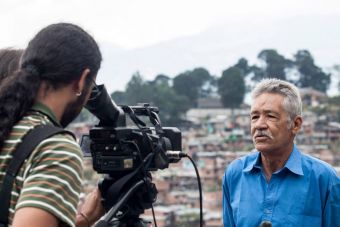
Medellin, Colombia
Alejandro Rodriguez is an MC and music producer and part of Old Guns, a hip hop collective from Comuna 13 in Medellin, Colombia.
Comuna 13 is a disadvantaged neighbourhood suffering from high levels of poverty and violent gangs. During the lockdown many residents could not make a living as they work in the informal economy as street vendors, builders, collecting rubbish and recycling. Thus, lockdown left them struggling to access food and essentials.
Picture left: Ciudad Comuna interview, Copyright: Ciudad Comuna
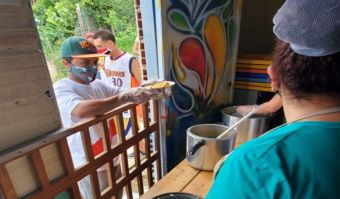
With the In Place of War grant, Old Guns decided to develop a community kitchen and allotment to address the issue of food insecurity in the area. They secured a building, partnered with a local community organisation, got permission from the gang leader who controls the area and enlisted an army of volunteers to work in the kitchen. During lockdown, the kitchen served 750 meals a week to vulnerable members of the community using produce from the community allotment.
Picture left: Kitchen serving meals during lockdown, Copyright: Alejandro Rodriguez
Caracas, Venezuela
Tiuna El Fuerte is an arts organisation located in El Valle, Caracas, Venezuela.
People living in tower blocks in the surrounding neighbourhood felt isolated and disconnected during lockdown, resulting in a decline in mental health.
Using the grant from In Place of War, Tiuna El Fuerte set up a mobile sound system and radio station, which travelled across the streets playing music and sharing messages over the sound system from loved ones across the community, helping people feel less isolated. They estimated that they reached over 20,000 people in two weeks.
Picture right: Tiuna El Fuerte’s Radio Verdura in the streets of Caracas, May 2020. Copyright: Tiuna El Fuerte
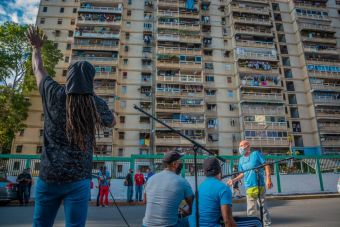
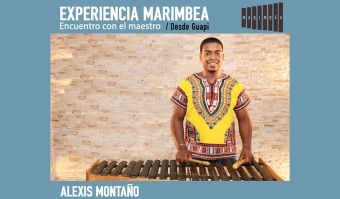
Cali, Colombia.
Marimbea is a cultural organisation based on the Pacific coast that works to promote Afro-Colombian culture through tours, performances and workshops. Due to the pandemic and lockdown, the community were unable to work and lacked access to basics. Using a grant of $1,000, Marimbea organised a series of online events, performances and workshops, paying the artists to participate and charging audiences to engage with the content. The events generated $2,000 in revenue and led to the development of a new digital content platform offering cultural experiences online.
Picture left: Promotion material for online workshop, Copyright: Marimbea
Reflections: What to learn for the idea of a Renaissance
These case studies provide interesting insights into the civic role of arts organisations in mobilising to address critical needs of local communities during the pandemic. This is hinged on a number of features. These organisations are committed to a place; often taking place in public spaces such as playgrounds, community centres, parks and schools, it is part of and shapes the local landscape. It is rooted in and part of their communities and thus artistic practice is designed by and for those communities. Given this, the art responds to the needs and aspirations of this community, and nurtures and celebrates the talent within the community.
Civic participation and artistic practice can not be divorced
This is a people-centric and local approach using artistic practice to facilitate human development, promoting positive values and social interaction and building communities. Given this, civic participation and artistic practice cannot be divorced: they are enmeshed and develop a symbiotic relationship. Art is a tool to engage communities which through participation leads to new artistic work and a more inclusive and diverse creative ecosystem designed to develop the community.
Indeed, one of the commonalities between these responses to the lockdown was that the organisations improved their standing within their local communities. Their work during the pandemic has elevated their status and visibility within the community and beyond. The creation of Trackside’s bakery and Marimbea’s digital cultural experiences are representative cases of this.
Picture right: Theatre performance about disability in Northern Uganda, Copyright: Mono Grande
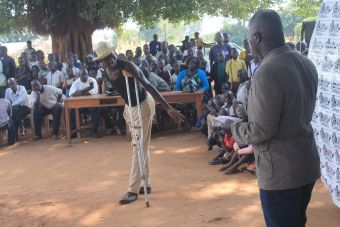
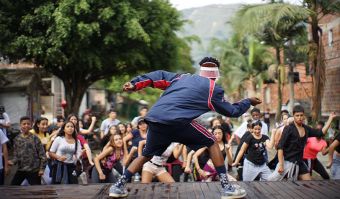
Radically nurturing artistic talents—and their aspirational community
We believe that, as in the case of our change-maker network, identifying and nurturing existing talent and projects in communities is key in developing genuine arts projects that respond and evolve to meet the needs and aspirations of the local community. Thus, rather than prescribing themes and agendas, offering support for the evolution of organic arts based community is of paramount importance.
Picture left: Dance class in Medellin Credit_Mono Grande, Copyright: Mono grande
Be innovative about funding social innovation
Similarly, developing more inclusive and open funding streams to enable grassroots, informal organisations to access funds to create civic arts projects is also key. We adopted a participatory grant-making model that allowed art organisations to develop responses that were tailored to their experiences and knowledge of their communities. They were not constrained by our preconceptions of what was the most critical need and this is clearly reflected in the range of responses the organisations developed. Small grants were distributed to informal groups and collectives as well as local NGOs which we were able to award without the need for clumsy and prohibitive due diligence processes, whilst crucially complying with charity commission regulations. Thus, in sum, the pandemic has illuminated the primordial role that local grassroots arts organisations can play in addressing critical issues facing communities, especially in times of crisis. They can be responsive and resourceful, generating immediate and real impact with little funding. This therefore invites us to rethink how we understand community arts projects beyond short-term interventions that respond to fleeting policy agendas and political strategies.
How can the cultural and creative sector foment grassroots, locally-led civic arts that showcase and celebrate talent in towns and cities in Europe both during and beyond the pandemic? How can we create inclusive and accessible funding processes so that such informal groups can develop and sustain their practice whilst generating long-term positive outcomes?
The creation of diverse networks and long-term relationship-building connecting commercial partners, governments, formal cultural institutions and grassroots collectives is key to fostering long-term arts-based social transformation in our communities—a transformation the green and digital transformations cannot do without—like, for example, the New European Bauhaus, the latest initiative of EU President von der Leyen highlights. Learning from the Global South how to empower arts-based social transformation in communities might strengthen a Next Renaissance in Europe while preventing one of its major risks: Of being a Revolution for the Privileged.
Links
Creativity Conquers COVID- A short documentary about the how IPOW’s change maker network responded to the COVID lockdown
Ruth Daniel
Ruth is a multi-award winning CEO, activist and change-maker. Inspired by the transformative use of hip-hop in the drug cartels of Medellin, Colombia, when a young MC said: ‘If it wasn’t for hip-hop, I would be dead. Hip-hop gave me another option and I’m truly thankful for that.’ Ruth believes art has a capacity to make change in the toughest of contex From guitarist at the age of 8 to record label owner, band manager, fundraiser, international cultural activist, entrepreneur, educator, influential speaker (TEDx) to prestigious award winner within a national arena (Social Enterprise of the Year & Manchester Woman of Culture to name a couple), Ruth’s passion to empower people to build their own positive futures through creative entrepreneur programmes, the development of cultural spaces and artistic collaboration shows no boundaries in terms of fields of work.
Picture © Katie Dervin
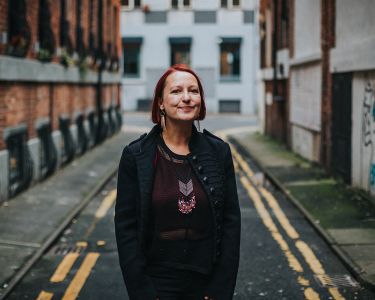
Teresa Ó Brádaigh Bean
Teresa Ó Brádaigh Bean is head of research and learning at In Place of War, a global charity that works to support grassroots arts based social change processes in sites of conflict. Her research interest and practice has focused on hip hop as a social movement, grassroots arts education, creative entrepreneurship in sites of conflict and community arts based peacebuilding. She has undertaken a number of research project exploring arts based social change processes mostly recently as a researcher on the the Art of Peace led by Prof. Oliver Richmond at the University of Manchester. She has played a key role in developing In Place of War’s education programmes. As a qualified teacher, she wrote CASE (Creative and Social Entrepreneur Programme). CASE was one of the five shortlisted finalists for the inaugural UNESCO-Bangladesh Bangabandhu Sheikh Mujibur Rahman Creative Economy Prize in 2021. It was awarded the Outstanding Contribution to Widening Participation at the University of Manchester’s Making aDifference Awards in 2017. The programme has been delivered in 14 countries including Bosnia, Uganda, Colombia, South Africa and the MENA. Teresa is an Honorary Research Fellow at the University of Manchester and a member of the Global Coalition on Youth, Peace and Security (GCYPS) a UN Inter-Agency Network.
Picture © Alexander Butcher
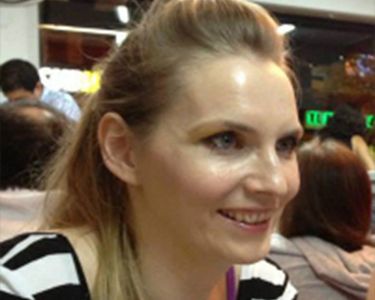
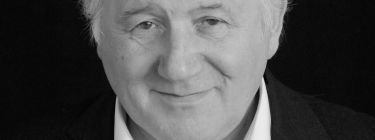
Renaissance 3.0
Artistic-scientific Director and CEO of ZKM Center for Art and Media, Karlsruhe and Director of Peter Weibel Research Institute for Digital Cultures at University of Applied Arts, Vienna
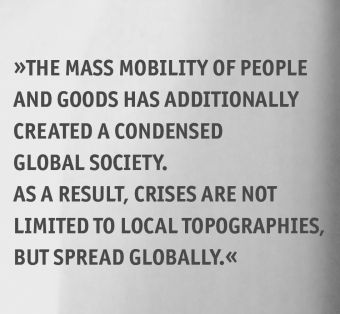
Renaissance 3.0
A scenario for art in the 21st century
The turn of the 21st century has been marked by a series of crises on a global scale. Through the infosphere, that electromagnetic envelope that surrounds Planet Earth and which we have been using for communication since the mid-19th century through radio technology, from telephones to satellites, a global society emerged in the course of the 20th century. News that used to take months from source to receiver—of earthquakes to stock market fluctuations—is now distributed almost simultaneously across the globe. The mass mobility of people and goods has additionally created a condensed global society. As a result, crises are not limited to local topographies, but spread globally. From the climate crisis to the migration crisis, from the financial crisis to the COVID-19 crisis, we are witnessing ever more profoundly shattering consequences. Principles of our civilisation built on the successes of humanism and the Enlightenment—for example, the universalism of human rights, equality of race, gender and age before the law, autonomy of the individual, freedom of the press and arts, democracy—are increasingly being challenged. Due to the climate crisis, the overall habitability of Planet Earth by humans—and thus humanity’s ability to survive—is being called into doubt. Mass migrations in the coming decades could therefore radically change the face of the Earth and the social systems that have
Picture above: Peter Weibel, Copyright: ZKM | Zentrum für Kunst und Medien Karlsruhe, photo by Christof Hierholzer
prevailed up to now. Therefore, it is necessary to propose a navigation system that prevents the failure of the mission of humanity on the good ship Earth. One of the possible scenarios for the future seems to us to be the revival of one of the greatest moments in human history, namely the Renaissance.
Most people think of the Italian Renaissance (15th, 16th and early 17th centuries) when they hear the term Renaissance, which stands for an era that surpassed anything that had gone before in terms of freedom, progress and discovery. However, it is important to note that there was an Arab Renaissance before the Italian Renaissance, from 800 to 1200, which has only come into focus in recent years.1
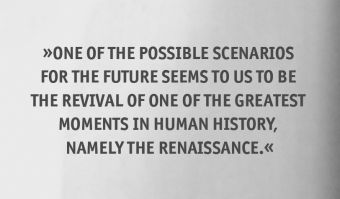
Italian Renaissance
The Italian Renaissance stands for a cultural revolution that ushered in a new attitude to the world and to humanity that was decisive in the history of the Western world. For many people, the Renaissance is regarded as a time of new beginnings, in which art and science flourished as never before and as never since. An example of this could be the painting La scuola di Atene (The School of Athens) by the painter Raphael, which he realised in the Stanza della Segnatura of the Vatican from 1510 to 1511. The title of this painting illustrates a central important aspect of the Renaissance, namely the rebirth of antiquity. Similarly, the rediscovery of Lucretius‘ ancient text De rerum naturae (On the Nature of Things) influenced artists like Botticelli, but also scientists like Bruno Giordano and Galileo Galilei. The last existing copy was discovered in a German monastery in 1417. Erwin Panofsky pointed out in his seminal work Idea: A Concept in Art Theory (1924) that the terms idea and type originated in the philosophical vocabulary of the Greeks, from which developed the cult of the ideal that prevailed in Europe until the days of Romanticism. That is why German masters such as Albrecht Dürer, and the three Nuremberg masters who worked with perspective representation——Lorenz Stöer, Wenzel Jamnitzer and Johannes Lencker—should also be considered.Decisive for the Renaissance, however, is Leonardo da Vinci’s quote, „Se la pittura è ’scienza o no,” with which he opens his famous manuscript Trattato della pittura (written circa 1490, published 1651). The claim was quite clear: „Painting is a science.” Renaissance, then, is the scientification of art. That is a central aspect of the Renaissance.
Up until the Renaissance, artists were considered craftsmen, belonging to artes mecanicae. In the Renaissance, they increasingly saw themselves as representatives of the artes liberales, i.e. as scientists and scholars. Renaissance artists repeatedly portrayed themselves as scholars, for example by featuring compasses, mirrors and small globes in their self-portraits as well as depicting their tools of the trade: canvases, brushes, perspective devices, and so on. Federico Zuccaro staged himself in his self-portrait as a reader of a book. These artists were concerned with optics and rays of vision and the theory of proportions. Piero della Francesca was, as it were, a calendar mathematician. He was interested in the doctrine of polyhedra.
A second central aspect of the Renaissance was the discovery of the individual. Whether in art, science, economics or politics, it was individuals who devoted themselves to exploring new horizons, new spaces at their own risk, be it the exploration of the seas by Columbus and Magellan or of celestial bodies by Galileo. The artist, the navigator, the explorer discovered new worlds, often against prevailing ideologies and doctrines. The Renaissance was thus the epoch of the triumph of individuality and this triumphant march has continued to this day. From the architecture of a Palladio to Titian, from Leonardo da Vinci to Giulio Romano, from Benvenuto Cellini to Michelangelo, we observe the the discovery of the individual.
Art as science and the expression of the individual’s abilities are thus the two most important aspects of the Renaissance for the future of art.
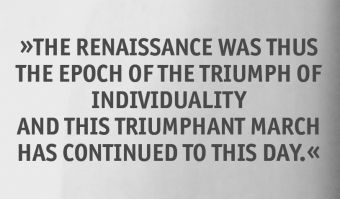
Arab Renaissance
But the Italian Renaissance was not the first scientification of art. The Arabic Islamic Renaissance occurred between 800 and 1200. The Banū Mūsā brothers created programmable musical automata around 850. Ibn al-Razzuz Al-Jazari wrote the book Compendium on the Theory and Practice of the Mechanical Arts around 1200. From Baghdad to Andalusia, Arab artists and scholars, such as Ibn Khalaf al-Murādī and Abū Ḥātim al-Muẓaffar al-Isfazārī, rediscovered and advanced Greek and Byzantine traditions. For example, the term algorithm comes from a Latinisation of the name of the Arab scholar Abu Jafar Muhammad ibn Musa al-Chwārizmī. As Hans Belting has documented in Florence and Baghdad, Abū ‚Alī Ibn al-Haiṯam (965-1040, known in the West as Alhazen) wrote Kitāb al-Manāẓir. His work was translated into Latin in the 12th century and contains fundamental studies on the propagation and refraction of light. The reception of Ibn al-Haiṯam’s theory of light and vision triggered one of the most exciting chapters in the history of Western art. Alhazen can be considered the inventor of the camera obscura and the forerunner of the invention of perspective. Perspectiva was the Latin title of his Arabic work on optics which was later replaced by the Greek term Optics and then again by the Latin Opticae Thesaurus (1572).
Renaissance 3.0
In this respect, the Arab Renaissance was the first, the Italian the second, and now in the 21st century there are convincing signs that we are experiencing a third Renaissance. In contrast to the two, relatively localised Arab and Italian Renaissances, the latest manifestation is global. Artists from China to Chile form a new generation of art-based research and research-based art. New works of art and scientific theories are emerging that do not only refer to the historical achievements of the preceding renaissances. Clearly, there are continuations of lines of tradition. For example, façade decorations by Falconetto in Verona foreshadow projection mapping on public buildings. Likewise, Paolo Veronese’s frescoes can be seen as precursors to immersive environments. In the future, new scientific disciplines, especially expanded forms of the life sciences, will determine our lives. The new society will therefore not only be about automata and robots; there will also be a shift from the mechanical and machine-based renaissances: that is, from hardware, to the new renaissance of software, programming, codes.
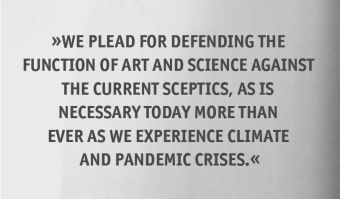
In this respect, genetics, molecular biology, all forms of the new life sciences, artificial intelligence, quantum optics, climate research, health care, the infosphere, the data society, questions of cyborg feminism (see Donna Haraway and Joanna Zylinska) will be central.
In the 21st century, there is a new basis for the convergence of the arts and sciences. Artists and scientists share a common „pool of tools“. Tools that dentists use, for example, small cameras that illuminate the oral cavity, are also used by artists. The same computers and screens are used by artists and scientists, as are algorithms and data networks. Mathematical equations slide over into genetic entities, both for physicists and artists, and geometric entities and fluid objects transform into data, into data curves, both in science and in art.
As long as art remained within the horizon of visible things that our natural organ, the eye, captures, it was difficult to build a bridge to science which, since the 17th century, has captured the world with instruments and apparatus, from telescopes to microscopes. With such apparatus, science opened the door to the previously inaccessible res invisibiles. As long as art refused to use such apparatus, it was fundamentally different from science. Art ended at the limits of natural perception. Science begins where natural perception ends, that is, beyond natural perception. With the rise of media since photography (circa 1840), media art also uses apparatuses and algorithms like science. This is the new basis of the convergence of science and art for a new renaissance.
The art of the 21st century will be dominated by this Renaissance 3.0 and will thus face the many challenges of humanity. One of these challenges is that the function of art and science to give meaning to the rerum naturae (Lucretius)—to the things of the world and nature, and to human beings—is being reinstated at this historical moment even as the function of science is being doubted. Hegel famously claimed that after religion and art, it is philosophy that recognises the absolute, that is, that gives us meaning and knowledge. We plead for defending the function of art and science against the current sceptics, as is necessary today more than ever as we experience climate and pandemic crises. The Renaissance 3.0 project will open the general public up to an unprecedented horizon of innovative works of art and, as the Italian Renaissance achieved, a new attitude towards the world and the future of symbiotic life of all living beings on Planet Earth.
References
1 Siegfried Zielinski, Peter Weibel, Allah’s Automata. Artifacts of the Arab-Islamic Renaissance (800-1200). Ostfildern: Hatje Cantz 2015
Peter Weibel
Peter Weibel is the artistic-scientific director and CEO of the ZKM Center for Art and Media in Karlsruhe and the director of the Peter Weibel Research Institute for Digital Cultures at the University of Applied Arts in Vienna. He is considered a central figure of European media art on account of his various activities as an artist, theoretician, and curator. He publishes widely on the intersecting fields of art and science. His career took him from studying literature, medicine, logic, philosophy, and film in Paris and Vienna to working as an artist and lecturer and then to heading the digital arts laboratory at the Media Department of New York University in Buffalo from 1984 to 1989. He later became the founding director of the Institute of New Media at the Städelschule in Frankfurt from 1989 to 1994 and professor of media theory at the University of Applied Arts in Vienna from 1984 to 2011. He was the artistic director of the Ars Electronica festival in Linz from 1986 to 1995, the Seville Biennial (BIACS3) in 2008, and the Moscow Biennale of Contemporary Art in 2011. He commissioned the Austrian pavilions for the Venice Biennale from 1993 to 1999 and was the chief curator of the Neue Galerie in Graz from 1993 to 2011. Picture © ZKM | Zentrum für Kunst und Medien Karlsruhe, photo by Christof Hierholzer

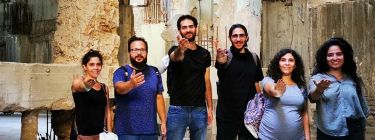
Is the show bigger than the art?
Director of theatre-based NGO Laban, Beirut
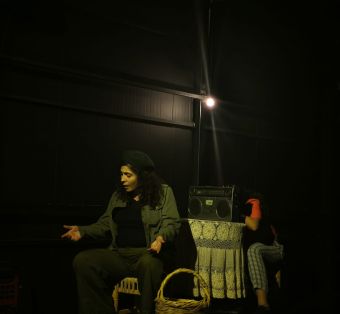
Is the show bigger than the art?
Producing Arts in times of revolution: Learnings from 30 years of Lebanon crisis about what artists might do and for whom in Renaissance
On 17 October 2019 in Beirut, Lebanon, I played the role of a dead fighter from the Lebanese civil war (13 April 1975- 13 October 1990). Twenty-nine years after the ceasefire in Lebanon, the civil war was still alive in the minds of the Lebanese. This open wound remains bleeding with thousands of missing, thousands of dead. The country proceeded with no reconciliation, no accountability, ruled by the same militia leaders and their customers until today. I call them customers as they are nowhere close to citizens: they live by and for the leader or political party, standing in the way of every possibility of change. Their relationship with the system is based on benefits to themselves, not rights and duties.
Picture above: Farah Wardani among several team members at the opera house that the people reclaimed during the revolution, Copyright: Laban
Picture left: Farah Wardani performing at one performance on the night of the revolution, Copyright: Laban
Malja’86 (Shelter’86) is a play based on stories of personal objects, all of which witnessed and survived the Lebanese civil war and were inherited by the subsequent generations. The objects are residues of a memory lost to the generation that experienced the war and the generations carrying the traumatic experiences of the past. This piece follows the story of Sami, who enters the memory of his grandmother, trying to look for his father. Inside her memory, he meets different characters from the past who might guide him—through their own memories and stories—to the truth about his father’s disappearance. On the opening night in Laban Studio, as I played Layla, the ex-fighter that lives in the memory of Sami’s grandmother, during a scene of a demonstration, I heard people chanting Thawra (revolution in Arabic). I felt immersed in the role; I had goosebumps all over my body. I felt a connection with my community, with this never-ending war, whose inherited trauma I hold in my psyche like every other Lebanese. After the show was over, I realised that thousands of people were marching the street right below our rooftop studio, on Spears Street, heading towards downtown Beirut, to announce the people’s revolution. I took a video on my phone and I knew this was the beginning of something huge.
Mlaja’86 opened that Thursday night and was expected to play until Sunday. However, the revolution took over the country and all activities were stopped to join the people on the ground. We, as Laban Studio, announced on our Facebook page, „In a matter of such national importance and duty, Laban is joining the civil protests in Martyr’s Square. Join us to raise our voice for the people and against the oppression. See you there!“
That was the right place for Laban and me as the director of this organisation.
On the streets, a woman approached my colleagues and me after we entered the Opera House of Beirut. The Opera House had been closed since the civil war. It was still closed as the same warlords wanted to demolish it and transform it into a hotel, or a personal business, erasing our culture as they did with several other cultural monuments. The revolting people took over several sites closed since the civil war in the heart of Beirut. The woman came and said, „You are the playback people. I thank you for this,“ with a hand gesture that contained the entire city, the country, the revolution.
We stood in awe and humbleness. ”Us? Why?“ my colleague asked.
She responded, „Your theatre taught us that we have a story worth sharing, we have a voice that we must use, and here we are writing our story, raising our voice, thank you!“ and she moved away on her bike. Yes, her bike. Quite unusual for Beirut. Here people only move in cars and buses. The city isn’t bike-friendly, it isn’t walking-friendly, it’s barely human-friendly. For a European reader, a bike in a public space is typical, if not the norm. No wonder that as we ask for fundamental human rights—Europe is on a carbon-free EU revolution.
The question here was, how do we do arts in the middle of all the beauty on the streets? Our safe space that was the closest thing to a public space, to a community that a Lebanese would dream of, was now too small in comparison to the streets and squares of the country, filled with citizens taking over the abandoned spaces and declaring them public, cultural, and collective.
Picture right: Poster for Malja’86 (Shelter 86) play, Copyright: Laban
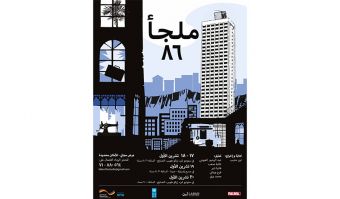
The revolution produced street art, social and political art, graffiti, songs, dancing circles, and discussions. Movies were made and spread across the world from mobile phones, and every chant was a masterpiece, every slash on a wall was a mural, every conversation was an improvised piece of art. What do we have to offer meanwhile? My team of 25 young people, Laban, is a theatre-based organisation, working since 2009 in Lebanon to create safe spaces of expression. After hours and hours of discussions, the team members met and decided that no art can contain the moment and taking our art forms into the street is a selfish act: Our work will be climbing over the revolution’s shoulders and will add nothing to it.
We decided to join our people. We took to the streets for months, experienced tear gas, rubber bullets, were assaulted by police thugs, got arrested, protested, shouted, chanted, danced, talked, and put our hearts, bodies, and intellect into this revolution as we do with our art. It was a collective masterpiece in the making. Meanwhile, the conversation didn’t stop: What do we do with our art? We are artists, and this is what we do for a living, to provide for our families, to survive.
„The one who opens something knows well how to contain it.” This wisdom came from a friend of the organisation. Let us perform our art to contain the individuals, not the community. In our playback, we always take the story shared by an individual, an audience member, to the communal level. We tackle the political in personal stories. Now we switched the game, now is the time to tackle the personal in all this political happening.
We had our first monthly performance around four weeks after the revolution started. People came in, a lot less than usual. The streets had all the eyes and light on them. We had our space opened for those who wanted to go small in the middle of the big act. Four weeks and violence was already happening, hidden agendas were surfacing, and the rhetoric of treachery was all over the mainstream media. The stories that emerged were, directly and indirectly, reflecting the fear of the people: how Lebanese people saw a glimpse of hope, an unusual hope. And now they were afraid of believing and losing, they weren’t ready for another grief, another loss, they weren’t prepared to be put down, again and again. Nothing as big as this revolution had ever happened in Lebanon, but it was the accumulation of the
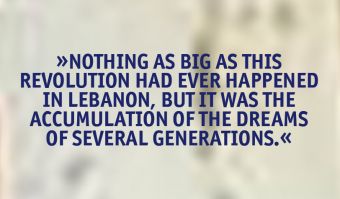
dreams of several generations. The stories were communal and political, but we focused on the personal. We listened profoundly and touched on the sharing’s most resounding note, and it was reflected on stage. Our stage served as a margin to the revolution.
Our art form is minimal and intimate. For several nights, I wished we did drum circles, street art, dabkeh dance, or any art form that could be transformed into jam sessions and that the masses could join in immediately so that we could go on the streets and engage with the people. I saw other artists taking their music, clowning, and dancing into the streets but what was happening was bigger than any framed artwork, from any rehearsed acts.
I was six months pregnant with my second child, and my first was four years old. We were on the street of Al Azariyeh, where six clowns were jumping and connecting with the people. A finance expert had some people gathered around him talking about the financial crisis.My son had his eyes all on the finance expert, totally ignoring the clowns, and when the man finished his explanation, my son started clapping hard. Unintentionally, the man had put on a show, he had stolen the spotlight from the clowns and everyone else. He had the charisma, the presence, the passion, and the devotion—all the factors you need to grab the attention of the young and the old. The clowns proved the theory that when the show is bigger than your art, you should make way for things to happen at their own pace. Your time will come.
Farah Wardani
Farah Wardani is a theatre actress, trainer, clown doctor, puppeteer and applied theatre practitioner.A theatre graduate with a DipHE, a BA in psychology, currently finishing her MA in Drama Therapy.
Farah is the director of Laban (a Lebanese theatre based NGO). A Playback Theatre practitioner, trainer, actress, conductor and faculty member of the ASPT, she leads drama therapy workshops with Intisar Foundation targeting Arab women victim of war.
Farah trains and uses Theatre of the Oppressed, Drama Therapy and other techniques with different communities and contexts as a medium for healing, social change and political activism.
Picture © Mohsen Al Zaher for Laban
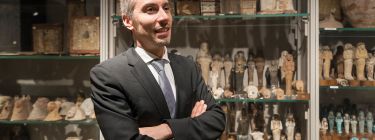
A millenary contemporaneity
Prof. Dr. Christian Greco, Director of Museo Egizio; Luca Dal Pozzolo, Director of Cultural Observatory of Piedmont at Fitzcarraldo Foundation, Turin
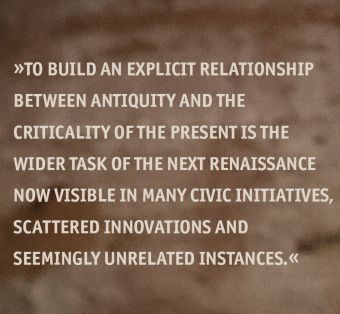
A millenary contemporaneity
The Egyptian Museum of Turin as a role model for societal dialogue and design of a desirable future
Archaeological museums have a great potential to express in the contemporary world, in showing how ancient societies have reacted to the challenges of sustainability and of their relationship with the climate, and how they have constructed cultural identities within an immense range of alternative ways of life and modes of thinking. To build an explicit relationship between antiquity and the criticality of the present is the wider task of the Next Renaissance now visible in many civic initiatives, scattered innovations and seemingly unrelated instances. This piece explains how this full vision is assumed by the Egyptian Museum and how it enriches with its cultural contribution of historical heritage the conceptual alternatives for the society at large in the design of a desirable future.
Heritages´ role for the future in crisis
As has been pointed out by anthropologists and sociologists, the present time has taken on an inflationary dimension which tends to overlap with the past and extends into the future, depriving it of its novelty and possible change: a formless and intrusive aorist that hinders the perception of the depth of history and the possibility/need for a different future. In this context, history has lost its role as the privileged key to interpreting society but, at the same time, the pandemic has highlighted the extreme fragility and uncertainty of a present that is anything but stable and predictable, furrowed by sudden fractures that open up disturbing trajectories. Moreover, a sneaking feeling of nostalgia for the pre-pandemic period and a recall to a presumed previous normality are all signs of how difficult it is to look straight at the heart of the current critical situation and imagine a possible new design for the future.In this condition, the crisis that has profoundly affected museums and cultural heritage as a result of the lockdowns runs the risk of being read from a reductive economic point of view, as the loss of an entertainment offer, the downsizing of a decisive asset of tourism, the economic damage by the suspension of activities.
Although all this is highly critical for the economic sustainability of museums, it is necessary to focus on the contribution and the cultural mission that museums and cultural heritage are able to offer in order to emerge from a crisis that shakes the 20th-century roots of our European societies.
On the other hand, at the international level, the idea that museums are theatres of memory where local and global identities are defined, and where different visions of the past and present meet the future, is now shared. This is precisely one of the central nodes to nurture a new impetus to address the current challenges to their complexity, and museums, libraries and cultural heritage are the privileged places to inhabit, share and structure the crossroads between multiple identities, new constructions of citizenship and paradigms for social, economic and cultural sustainability.The need to recover the perception of the depth of time and of a future that is to be built through the choice of alternatives is today one of the great challenges that museums and cultural heritage can help to address, provided they are radically transformed: overcoming the concept according to which artefacts are exhibited and separated from their historical context, showing them as objects of particular beauty. Isolating them from their original context does not allow us to interpret an era.
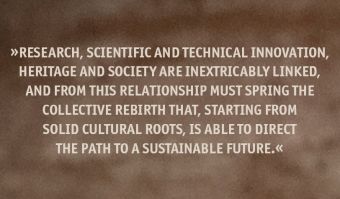
All this implies an epochal passage from a logic of relationship with the public centred on the exhibition, to a dimension of producers of content, both for the public in presence and for the public at a distance as the pandemic has shown.
Although there’s no better way to enjoy heritage than in person, not even with the most sophisticated digital technologies available, museums and cultural heritage can no longer be understood primarily as physical containers to be filled with tickets, but as cultural publishers, capable of graduating their reach and disseminating cultural products on all possible supports towards the public in presence, the distant public, schools, universities, civil society, sewing up the past with the dimension of the future.
Innovating the futures´ context for heritage: The Egyptian Museum's commitment
At this decisive point in time, the wider aim is to perceive museums as laboratories of innovation, fundamental for the harmonious development of society, and as reference institutions for the construction of contemporary knowledge that must now face new challenges. Only in this way will we truly give voice to what Article 27 of the Universal Declaration of Human Rights, approved on December 10, 1948 by the General Assembly of the United Nations, clearly reminds us. Research, scientific and technical innovation, heritage and society are inextricably linked, and from this relationship must spring the collective rebirth that, starting from solid cultural roots, is able to direct the path to a sustainable future.
The Egyptian Museum of Turin is leading in such innovations of the narrative of its contents and experimenting with new ways of relating to its public. Below is a brief description of some of the research guidelines inspired by the approach described above and the related actions that characterise the daily work of the museum.
The alliance between science and archaeology
The places that preserve the vestiges of the past can function as laboratories of innovation, experimenting with new techniques of investigation, through which it is possible to ‚interrogate‘ the objects in different ways. In this field, a real dialogue between humanists and scientists can produce truly innovative results, combining the potential offered by modern science with the questions suggested by objects but still unanswered. The time has come to introduce what we could call a digital humanism in which archaeologists, anthropologists, architects, historians, philosophers, neuroscientists, and psychologists work side by side with chemists, physicists, and computer experts to arrive at the definition of a new semantics that allows us to understand and process the complexity of reality. Starting from, for example, the exhibition Invisible Archaeology, the Egyptian Museum offers the heritage of questions, acquisitions, hypotheses and problems to be faced and explained to different audiences. The alliance with science for the reconstruction of the complexity of life and everyday life does not only imply a low invasiveness of the investigation and delicacy in the impact on the finds (a factor of absolute importance) but also the sharing of the knowledge and awareness of the public distant eras.
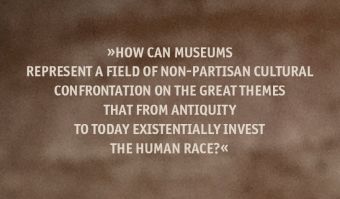
Science and the sacredness of life
The scientific investigation does not only concern objects and findings of material culture, but puts at the centre of its diagnostics life itself through the investigation of mummies and human remains that represent deposits of valuable information on lifestyles, diseases, genetic makeup, and so on. For the Egyptian Museum it is necessary that these investigations and analyses be returned to the public as a positive approach against the objective risk that every exhibition and every museum runs: the evocation of the gaze of the Gorgon that petrifies every object on which it rests. Fighting the dehumanisation of the mortal remains of life, degraded to crystallised relics, no longer worthy of the pietas that was among the reasons for their coming into our presence, is an ethical commitment assumed by the Museum, starting with the debate on the appropriate way to display human remains. Explaining how scientific and genetic investigations with similar methods can be applied today—not only to lives extinguished thousands of years ago but also to the recent deaths of migrants at the bottom of the Mediterranean Sea in order to give them back their names and identities—opens novel societal questions, rooted in the distant past and facing our future and that of our children.
The Egyptian museum as part of a living geography
An archaeological museum dedicated to Egypt runs the risk of being placed in a subsidiary temporal sequence—before the Greeks—but in an ancient geography, no longer related to contemporaneity. Precisely to prevent this possible interpretation, the policy of recent years has focused—also with promotional and marketing initiatives—on the relationship between the museum and Egyptian, Arabic-speaking and African communities in Italy and Europe, to allow opportunities for cultural recognition and pride, for in-depth studies of history and for comparison between places of origin and residence. Egypt is not only a region of history, or a place of excavation and scientific cooperation with which the Museum shares intense exchanges, but one of the most influential countries in the geopolitics of the Mediterranean and an inevitable point of reference for thousands of new citizens. An effective reception policy and the construction of an intercultural society are also based on the recognition of the cultural values of others, on their valorisation, on the possibility that cultural heritages can be reciprocally known and shared, negotiated in their implications and underlying values, and not used to build oppositional, exclusionary identity exoskeletons based on the denial of the other.
The contemporaneity of the past.
The commitment to proposing innovative trajectories, in extreme synthesis, is aimed at making evident to the different audiences—with every, narrative, literary and technological instrument available—how archaeology, probing ancient time, contributes to questions about and redefines the present. This is a necessity as well as a challenge to museums if they opt to be a driver for the Next Renaissance Europe: How can museums represent a field of non-partisan cultural confrontation on the great themes that from antiquity to today existentially invest the human race? The most recent one is the overwhelming transformative power of our societies, which puts at risk the sustainability, not of the planet but of the human species in its development trajectories. The Egyptian Museum hopes to be an inspiration and living lab for museums across the globe, extending here and now an invitation to collaborate and co-create the future of museums for the future of a resilient society. In fact, the scientific investigation in archaeology is one of the most interesting frontiers in the challenges of contemporaneity.
Luca dal Pozzolo
Luca Dal Pozzolo, 1956, Architect, co-funder and responsible for Research of Fitzcarraldo Foundation. From 1998 is Director of Piedmont Cultural Observatory and member of the Scientific Committee of CCW, Cultural Welfare Centre and Member of the cultural Commission of the European Institute of Design (IED). He teaches in Bologna Economic Faculty, (Regional Cultural Policies), in Politecnico di Torino (master in museography) and in Lugano, Master in Advanced Studies in Cultural Management.He designed many museum’s exhibitions and cultural institutions and published many articles and books on cultural economics, museums and Heritage, (Esercizi di sguardo, 2019, Il patrimonio culturale tra memoria, lockdown e futuro, 2021), and is directing the book series Geografie Culturali, for the Italian publisher publisher Editrice Bibliografica.
Picture © Fondazione Fitzcarraldo
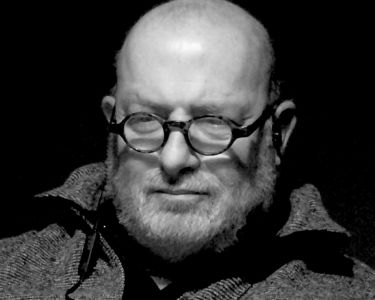
Christian Greco
Born in Arzignano (VI) in 1975, Christian Greco has been Director of the Museo Egizio since 2014. He managed a refurbishment of the museum building and a renovation of its galleries, completed on March 31st 2015, whereby the Museo Egizio was transformed from an antiquities museum into an archaeological museum. Trained mainly in the Netherlands, he is an Egyptologist with vast experience working in museums. He curated many exhibition and curatorial projects in the Netherlands (Rijksmuseum van Oudheden, Leiden; Kunsthal, Rotterdam; Teylers Museum, Haarlem), Japan (Okinawa, Fukushima, Takasaki and Okayama museums), Finland (Vapriikki Museum, Tampere), Spain (La Caixa Foundation) and Scotland (National Museum of Scotland, Edinburgh).While at the head of the Museo Egizio, he has set up important international collaborations with museums, universities and research institutes all across the world. Christian Greco is currently teaching courses in the material culture of ancient Egypt and museology at the University of Turin and Pavia, and he is Visiting Professor at the New York University in Abu Dhabi. Fieldwork is particularly prominent in Greco’s curriculum. For several years, he was a member of the Epigraphic Survey of the Oriental Institute of the University of Chicago in Luxor. Since 2011 he has been co-director of the Italian-Dutch archeological mission at Saqqara. Greco’s published record includes many scholarly essays and writings for the non-specialist public in several languages. He has also been a keynote speaker at a number of Egyptology and museology international conferences.
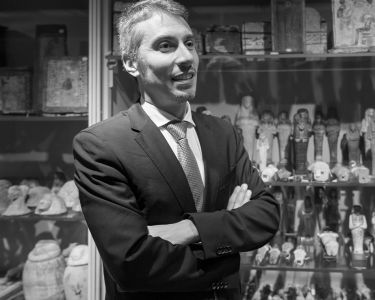
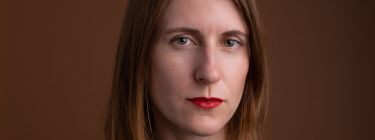
If there’s to be a New Renaissance, let it be a Renaissance of humanity
Milota Sidorova, PhD, Director of Urban Studies and Participatory Planning Department at City of Bratislava
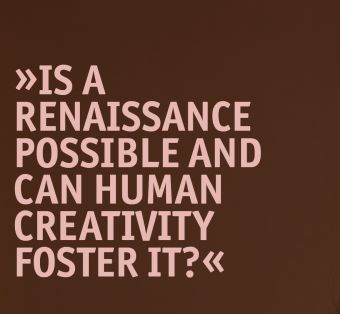
If there’s to be a New Renaissance, let it be a Renaissance of humanity
(and let’s start with the young ones)
If there is something to connect the renaissance of old with our times, it would be a need for humanism. But what does that mean on a level we could grasp in our personal and professional lives? Let us contemplate the humanism of current times, people living in cities and finally city governance. When I was asked whether it was time for the next European Renaissance, my initial response was laughter—you know, the one where laughter mixes with tears. First, the world seems a very chaotic place to me, literally changing from week to week. Things I had considered certain—open borders, travel, international relationships, job opportunities, even tolerance—are no longer so. Who the hell is running my country, I ask myself? Feelings vary between exhaustion, disgust and resilience. Don’t get me wrong: I am no pessimist. But in order to move forward I often lapse into periods of cynical silence and combat. It seems to me that I dwell in one such period right now—and here comes the question: Is a Renaissance possible and can human creativity foster it?
Picture above: Milota Sidorova, Copyright: Milota Sidorova
Drawing parallels with the Renaissance of old
The Renaissance of the past had things in common with our days. The collapse of feudalism can be compared with the present crisis of capitalism, a system that has evolved for more than four centuries. Just like feudalism at that time, capitalism can no longer meet the demands of modern society and its inherent growth paradigm causes the destruction of the environment. In addition to a socioeconomic shift, the old Renaissance saw a massive growth of education—later on galvanised by the invention of a printing machine. That resulted in a widespread growth of schools. Information was spreading faster, contributing to the emergence of new ideas and thinking. Suddenly, more than ever before, one could access information. Arts, science, medicine, overseas expeditions, technological and urban growth—all of this opened wider horizons to the human world.
Most disciplines only emerged from shared roots of philosophy and later specialised. In this unique time it was possible for a man to become a so-called Renaissance man of significance. I am not sure if a person like Leonardo da Vinci would exist today. Innovative yes, craftsman or scientist, maybe, but probably not. Definitely a businessman rated in some of those global financial magazines. But this is not a question today—although we love the idea of masters, superheroes, winners, talented men (nowadays even women), the truth is, such personas do not have much to do with creativity as I mean it. Oh, and a note to education—it seems that after centuries of specialisation and technological progress, we are at a crossroad once again. For the past decade almost all disciplines have experienced an increasing urge for interdisciplinarity. Daily, we live with a growing need to cultivate a holistic approach towards the complexity of the world. But we may be heading in the opposite direction. Perhaps it is time to bring philosophy back to the game.
The Renaissance of old was characterised by huge social and economic inequalities and epidemics. This seems a convenient resemblance to our times. Yet to simply say, Yes, it is the same story, would be rushed and definitely wrong. Genetically, as biological beings, we humans haven’t changed that much since Leonardo`s time. But as a society we live in a radically different, complex world, enhanced by the internet and by free movement—a world that cannot be compared to those late medieval people.
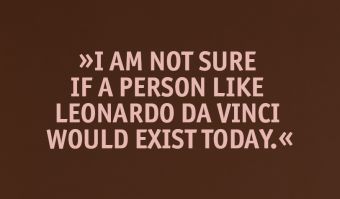
The new Renaissance must be humanistic
If there is something to be shared with the Renaissance of old, it would be humanism. Not only in the sense of a human-centric vision of the world in emerging disciplines, but also in terms of humanistic ideas that were essential to future democracies and to the progress we have made. So when I am talking about technological revolutions driven by Artificial Intelligence, science revolutions speeded up by the vaccine rush or a green revolution, it is essential we don’t omit humans from the epicentre of these revolutions. If any revolution should happen it should be a revolution of humanism—with technology, digitalisation, scientific progress and environmental protection being the fields in which we operate.This is a fairly optimistic idea—and somehow hard to connect to the reality of our populist politics or bullying on social media, say. How do we want to run our society oriented on humans when there is so much hate and chaos around us, all in such a high speed chase?
So the first revolutionary question to our post-pandemic renaissance would be, Where are we? How have we suffered? How did we get out of touch with others? It is true that most of us remained isolated or in small groups with mostly disembodied connections to the outside world. Other people became estranged at best. I sense that connecting to neighbours and other people would be something of much needed societal therapy. And positive, human and inspiring language from the media and from political leadership would be a requirement too.
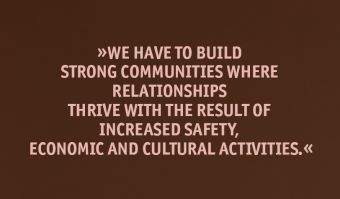
Recovery of what?
These days most European countries decide how they allocate and spend funds from the so-called Recovery plan. It seems quite short-sighted and regressive that most of the funds are spent on huge infrastructure projects and so little on humans—education, culture, healthcare systems, the recovery of communities. We have to build strong communities where relationships thrive with the result of increased safety, economic and cultural activities. Let me be more specific. If we are to foster creativity in communities, let us think first of safe communities which are not threatened by a lack of basic needs and rights. You can hardly grow a band like the Beatles out of a burning refugee camp. But you can foster a lot of inventions out of human curiosity. Curiosity is the key to creativity, whether it ends up in artistic production, a company or a happy family life—where a lot of creativity is required! The state of curiosity
is the opposite of being locked down and defined. It means openness to tolerate a new thing to happen and learn from it. And for curiosity to flourish, especially after such a difficult period of isolation, we need to acknowledge the need for relationships (the very essence of humans) and critical thinking (as a compass to navigate through the complex world of information and disinformation).
A friend of mine, a couple therapist, suggested to me recently, If people did not know what depression and anxiety meant before the pandemic, now everybody knows. Such a simple yet powerful thought! We did it all together, in a way: All this shared misery connected us on a human level.
How we are to rise from the bottom to rebuild the world remains a different question. In fact, we did not suffer a destructive war, not in terms of infrastructure. There are no destroyed cities left after pandemics. But we have to rebuild our relationships, trust and political behaviours as democracies have been under pressure. The Pandemic—and the lockdowns and public anxiety that came with it—actually served authoritarian figures to establish their powers and diminish democracies. In countries like Hungary, Belarus, Slovenia,
Poland and the Czech Republic we can witness that the system ensuring public benefits and resources while guaranteeing individual rights—the system that we call liberal democracy—is under threat.
As I spoke to my friend—me, an urban planner, him a therapist—we discussed differences we saw among mayors of cities and national politicians. The truth is, here in Slovakia we could not find even five inspiring, cause-oriented politicians—male or female—on the national level. On the other hand, we spoke a lot about the growing popularity of many mayors—male and female—who did well in the pandemic. They did well because they focused on the reality of human lives and worked for everyone. They completely abandoned debates between left and right, liberal and conservative, that normally fill media space and focused on real things like helping people get tested and vaccinated, providing food delivery and social care for the elderly, and simply informing citizens of the reality of the pandemic. So here is one takeaway: If any revolution should happen, it should avoid empty politicising without action and focus on serving humans. Sometimes words are empty of meaning. These politicians did well because they found a different way of doing politics.
Resilient leaders taught from childhood
Poland is on the verge of an ideological political battle, yet a few years ago I noted there were few cities (Gdynia, Wroclaw, Lubin) with mayors winning three or four election terms. These cities have had long-term growth, continuity and it seems that the various tectonic shifts on the national level did not affect them that much. Common features uniting all these mayors were not only that they remained relatively unpartisan, being able to negotiate with different parties, but they focused on solving real issues—housing, greenery, mobility, public spaces, culture—thus gaining the trust of their citizens. But a truly surprising moment for me was the realisation that all of them were members of the Scout movement. Being a Scout myself, I looked around and found more popular mayors and city administrators, male and female, being members of this movement, in Slovakia and elsewhere. Don’t you think this is interesting? I asked my friend Andrej.
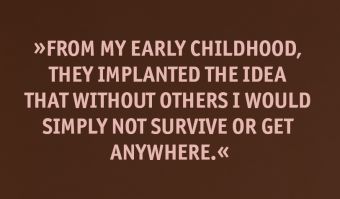
I remember that from a very early age Scout leaders taught us teamwork, leadership, public service. And we were constantly outdoors, in connection with nature and cities. From my early childhood, they implanted the idea that without others I would simply not survive or get anywhere. And that in any situation or narrative you have to look for ways to deal with it.
Interesting, indeed, Andrej replied. I recognise the same behaviours among people who were also members of a sports organisation called Sokol.
Sokol or “Falcon” was a youth sports club widespread in
Czechoslovakia during communism. Similarities to Scouts were apparent. Both stressed teamwork, physical activities, being outdoors—and both were affordable.
Interesting, he continued. People spending their youth in these organisations were more likely to maintain focus on the cause, rather than on changing rhetoric. Also, in their relationships they tended not to repeat mistakes from their family behaviours, he added.
Finally, I found something that could answer my need for humanistic revolution on a scale that I could grasp and do something about.
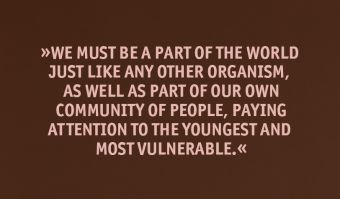
Affordable youth organisations—key players in resilient cities
Now, let’s think about the future. In order to have one, we have to literally work out societal integrity, critical thinking, and resilience against illiberal ideologies. We have to focus on wellbeing and chances for the next generations while protecting the environment. All of these values were taught and practiced by both the organisations mentioned above, while they were widely affordable to children from all social circles—in contrast to exclusive private kindergartens, schools and universities which fostered the same values, except that of affordability, thus creating a future elitist class.
To heal relationships and societal integrity we have to teach generations of people who will naturally live according to these principles. We all know how difficult it is to convince a grownup—so let’s focus on the youth. Besides, young people can also teach their parents a great deal. What if we sought these (and other similarly oriented) organisations actively and as public administrators offered them partnerships, affordable rents for their community spaces (that is what they mostly need) and let them do the job?
Yeah, this doesn’t sound too much of an innovative idea, definitely not like a tech-start-up or creative cluster program—and less likely to attract investors or employers. Because they are involved in lives much earlier, have daily presence, and shape us and our kids for the future. Most of them are on decline as cities become more expensive and lifestyles change. Because they operate on low budgets, they are neither very visible nor prominent. Thus they hardly gain our attention.
But here’s a proposition: Let us find them, help them. Let us integrate them into our recovery plans, helping them to guide people from a young age in the humanistic philosophy we all need. There is no longer room for us to prefer higher economic, political and power interests to people, human interests, needs and rights. A paradigm shift is needed, focusing not on economic output and endless accumulation at the expense of more disadvantageous and future generations. Human relationships with each other and with their environment must be at the epicentre of such a paradigm and that will be a return to humanism—and therefore to what it means to be human.
Rather than being held powerless, the youth can and should
contribute to community readiness, response, recovery, and resilience. While youth vulnerability is well established, their involvement in readiness and response has received relatively little political attention, even though youth who are informed and engaged are better able to protect themselves and others. This goal could become part of community renewal plans and policies, bringing us closer to the future—and through young ones to a hopefully more stable, resilient society and the new emerging economy of care. With such a society I believe digitalisation, environmental protection or any other challenge could be handled in a more equitable way.
We must be a part of the world just like any other organism, as well as part of our own community of people, paying attention to the youngest and most vulnerable. If there has to be a humanistic, inclusive Renaissance for everyone—this I can sign up for! Anything else is an abstract illusion.
Note: This is a free-thinking essay and I thank my friend Andrej Zemandl for sharing his experiences and thoughts with me. He was a great inspiration for writing this piece.
Milota Sidorova
Milota Sidorová, Bratislava, Slovakia Feminist, urbanist and author in service of more inclusive cities
Picture © Milota Sidorova
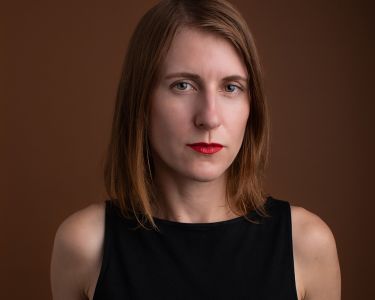
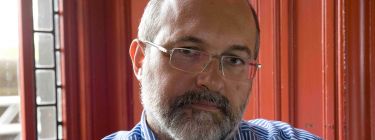
Renaissance by mistake
Prof. Pier Luigi Sacco, PhD, Professor of Cultural Economics at IULM University, Milan
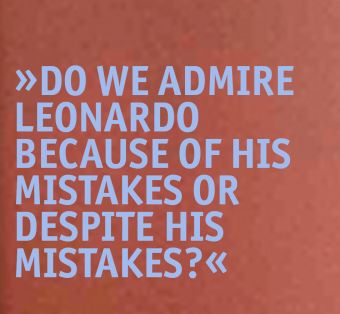
Renaissance by mistake
Spirit, are you there?
Leonardo da Vinci is probably the most acclaimed creative mind of all time and the epitome of the Renaissance man. His knowledge, talents, vision, and imagination spanned several disciplines that sadly now constitute different cultures: Science and Art. We admire Leonardo so much not only for what he did, but also and maybe even more for what he anticipated: in his notebooks, he figured out ideas and possibilities that would only become a reality several centuries later. And yet, if we think of it, most of what we admire Leonardo for did not work. His tank or his submarine, to cite a few famous examples, are brilliant intuitions, but nothing more. Even an artistic masterpiece like The last supper is in critical condition because Leonardo experimented with a new painting technique of his own invention, a tempera grassa, that would fail to stick properly to the humid wall. A detractor of his time would not have been in a difficult position in depicting Leonardo as a fraud by selectively picking a collection of such incidents. But his experimental, risk-taking attitude was a constant feature of his creative method. This raises an interesting question: Do we admire Leonardo because of his mistakes or despite his mistakes?
Mistakes and the Renaissance Men: then and now
We could be tempted to say, Neither one nor the other. We do not admire Leonardo because he did something wrong, but because he was visionary enough to imagine possibilities that were much beyond the technological standards of the time, and inevitably he could not get them right given the current state of knowledge. At the same time, blaming him for not getting them right would be totally unfair in view of the fact that actually working submarines or tanks would in the first place require engines that were inconceivable at the time of Leonardo. But can we really separate in any way Leonardo’s prodigious ingenuity from the ‘mistakes’ it produced? After all, most of Leonardo’s imagination of possibility comes from a careful and most insightful observation of nature: his machines are distillations of design principles found in animal bodies, and of reflections on the action and properties of natural forces. And like Leonardo’s, such evolved principles have in turn been built by nature on the basis of
constant trial and error, of endless refinement of mistakes: After all, what else are the copying glitches that cause genetic mutations?
In the constant lip service to Renaissance that is so much characteristic of our times—the idea of Renaissance has probably never been so popular as it is nowadays so that practically every day somebody calls for a ‘new Renaissance’ of some kind—we seem to have learnt this lesson in its iconic translation in the biographies and visions of those who are generally reputed and celebrated as the contemporary equivalents of the Renaissance man: self-made digital economy tycoons like Steve Jobs, Sergey Brin and Larry Page, or Elon Musk, all of whom have built their fortunes through a relentless toggling between moments of sheer defeat and utter triumph, with the former providing the lessons that paved the way to the latter. Samuel Beckett’s “Fail again. Fail better” quote has become the most famous inspirational quote of Silicon Valley culture (and it is difficult not to feel the irony of all this). We have understood how to make sense of mistakes and profit from them, after all.
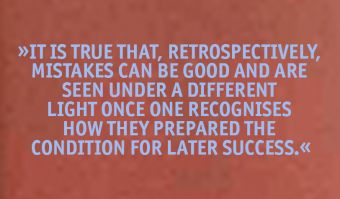
A culture of making mistakes is not a mistake in culture
But is this really the case? It is true that, retrospectively, mistakes can be good and are seen under a different light once one recognises how they prepared the condition for later success. But when mistakes are made, it is much more difficult to take them cheerfully, especially when one is moved by an enthusiasm and sense of possibility that clash with sudden, sometimes brutal denial. Being mistaken may sometimes sound like being treated unfairly in terms of lack of responsiveness to something that deserved more attention and consideration, and it really hurts. What is or is not a mistake does not depend only on objective conditions but may also reflect social circumstances. A good idea can become a mistake when it is proposed ahead of the time and is basically not understood by others—but is it then a fault to see things long before others do, as
Leonardo did? Or can it become a mistake because it conflicts so much with the incumbent vested interests that it becomes a threat that needs to be eradicated? To change a mistakenly good idea into a success, sometimes you do not need to change the idea, but the environment. And this is, ultimately, what the Renaissance largely did (to be fair, not in opposition to a supposed, previous Dark Age as it has been long contended, but through a seamless development of
long-baked previous ideas). It created a social milieu that was welcoming and favourable enough for creative minds that would have been out of place and out of context in most other societies, and whose ideas would have been refused as mistakes in different circumstances—as it would become clear a bit later in the gloomy times of the Counterreformation.
Todays Paradoxes trapping a Next Renaissance
So, the question becomes: Are we prepared to take the responsibility of what it means to invoke a new Renaissance? Are we prepared to set the context for good ideas not to sour into bad mistakes? The same society that celebrates Renaissance genius is keen to embrace an educational model in which only STEM disciplines matter (“Leonardo, stop wasting your time painting and try to make that damn plane fly!”). This same society seems to be willing to cut funds for basic research to reallocate them towards ‘useful’ applied research (“Leonardo, stop wasting your time with that tank thing and come up with a practical idea!”). It is easy to see how our current choices are turning into ‘mistakes’ the same attitudes that we retrospectively celebrate. Paradoxically, what attracts us to the idea of Renaissance genius is that we leave our trust to the creative vision as a way of maintaining our own need for assurance and risk-aversion (‘the genius will do it right, even if I do not understand how and why’). However, what makes it feasible is exactly the contrary: Responsibly embracing collective risk-taking is the only viable context for successful creative ideas.
So, what does a ‘new Renaissance’ mean today, concretely? It means being able to create a social attitude of openness toward the weird and the unfamiliar. Weird, unfamiliar things can be very irritating, and we are generally not very good at managing irritation. Truly new ideas are often refused not because they appear too complex, but because they appear too stupid—largely because we are not able to appreciate their real depth and complexity. Weird, unfamiliar things call for cognitive and emotional effort. But we live in a world in which we are much too keen to simplify things to people. And perhaps not accidentally we witness an unprecedented flourishing of spurious or entirely fabricated knowledge (‘conspiracy thinking’) whose only real appeal lies in its nodding to our need to understand the world through ideas and categories we are already familiar with and require no real learning or cognitive effort. We are often suspicious of anything that challenges our prejudices and intuitions.
Recovering the Renaissance spirit
The road to a ‘new Renaissance’ is long and tortuous, and it passes through an unprecedented mass flourishing. To turn mistakes into good ideas we need societies that are ready to venture into the unfamiliar with grit and curiosity, and that have the patience to absorb delusions and the generosity to overcome partisan thinking. But this sounds exactly like the opposite route to the one pursued by the business models of many of those digital giants who, ironically, we celebrate as the modern incarnations of the Renaissance spirit. These are businesses that profit from the increasing polarisation of the public opinion and from the formation of echo chambers that commodify people’s prejudices.
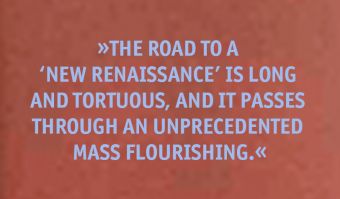
Recovering the Renaissance spirit is about turning the tide. Digital culture can become the platform for a new Renaissance if it does what the Renaissance once did: creating a social platform for an unprecedented form of collective intelligence. And Europe can play an important role in this process exactly because it does not have such an incumbent interest in the extraction of value from the status quo as is the case for the Silicon Valley giants. Europe can pursue different possibilities because it has much less to lose—and much more to gain. But to do so, we need to recover the true social dimension of the Renaissance whose locus is not the studio of the solitary genius, but the square: the centre of community life, the
theatre of exchanges and encounters. The Renaissance square is inclusive, it is a public space that everybody can inhabit as a peer, and it is pertinent that the square as the centre of human-scale community life is a typically European urban phenomenon.What is the public space that we may inhabit in our ‘new Renaissance’, and where is it? What are the conditions for access, and who controls them? What ensures that it is diverse and inclusive enough to welcome mistakes and turn them into good ideas? These are the questions that we need to credibly answer if we want to take a new Renaissance seriously. And not to do it would be a mistake—one that would be difficult to turn into a good idea under all circumstances.
Pier Luigi Sacco
Pier Luigi Sacco, PhD, is Senior Advisor to the OECD Center for Entrepreneurship, SMEs, Regions, and Cities, Associate Researcher at CNR-ISPC, Naples, and Professor of Economic Policy, University of Chieti-Pescara. He is also Senior Researcher at the metaLAB (at) Harvard. He has been Visiting Professor and Visiting Scholar at Harvard University, Faculty Associate at the Berkman-Klein Center for Internet and Society, Harvard University, and Special Adviser of the EU Commissioner to Education, Culture, Youth and Sport. He is a member of the scientific board of Europeana Foundation, Den Haag, of the Advisory Council on Scientific Innovation of the Czech Republic, Prague, of the EQ-Arts Foundation, Amsterdam, and of the Advisory Council of Creative Georgia, Tbilisi. He regularly gives courses and invited lectures in major universities worldwide, published about 200 papers on international peer-reviewed journal and edited books with major international publishers. He works and consults internationally in the fields of culture-led local development and is often invited as keynote speaker in major cultural policy conferences worldwide.
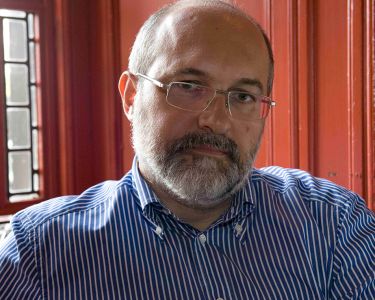
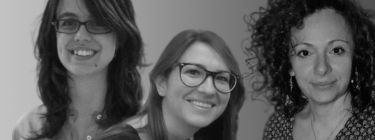
Human-Machine Interfaces, intelligent systems and cultural heritage
Maria Giulia Losi, PhD, Project Leader and Interaction Designer at RE:Lab; Silvia Chiesa, PhD, Project Manager in the R&D group of RE:Lab; Annalisa Mombelli, R&D group of RE:Lab, Reggio Emilia
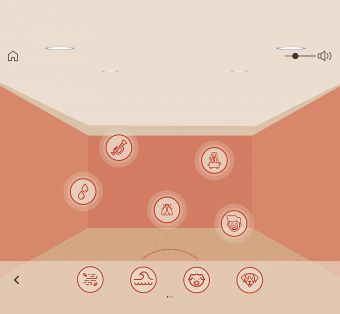
Human-Machine Interfaces, intelligent systems and cultural heritage
Perception might be reality
In today’s context, related to health emergency, some aspects of technological design assume a peculiar role. The first is the theme of distance; the second is the theme of the extension of sensory capacity through digital technologies; and the third is the recognition of the state of the subjects. These three sets of factors, the need to manage distance, the need to extend technological sensoriality into the distance, and the need to recognise in the distance not only the sensoriality but also the state of the user—whether a patient, driver or viewer—thus constitute a new axis of technological design.
Picture left: Interfaccia suono, Copyright: RE Lab
A new anthropocentric setup for technologies
This new axis prefigures the attempt to fill the gaps, the attempt to relaunch an idea of technology that can bring people together, even in this current social framework of difficulty. Therefore, starting from this idea of rapprochement, a new anthropocentric approach to technological performance can be founded, which is undoubtedly one of the central axes of a New Renaissance, based on the integration between the anthropocentric culture of the Renaissance tradition and the potential 4.0 of the technologies mentioned above: those intended to extend the sensory framework; those intended to increase the recognition of the subject and respect of his emotional and cognitive state,; and finally those oriented to extend his ability to live experiences not necessarily in presence.Starting from this premise, RE:Lab, in the framework of the activities of the Emilia Romagna Region, wanted to compose this complex puzzle with diversified initiatives within several projects. First of all, in the midst of the pandemic, the experience of restitution of a phenomenon of intense bodily relations such as dance was sought. Subsequently, the idea of extending the sensory capacity in the relationship, born even before the health emergency took shape, was resumed and developed, and then relaunched during the pandemic experience through the concept of an Atelier, that is, a creative space that takes into account the management of sound manipulation. Finally, we added the idea of including in the processes of technological relations the recognition of the state of the user, not only cognitive but also emotional, so that his emotions allow to recognise the state of use and on the basis of this to orient and design systems of safer and more effective interactions.
A Living Lab for Novel Human-Machine Interactions – A New Grammar for Dramaturgy and Choreography in Digital Space
How can user experience design foster innovation processes in the dance and live performance sector?In a historical moment like the current one, where distance has become one of the hallmarks of experience, the performing arts and dance sector has been put to the test. At the beginning of 2020, the Aterballetto Dance Foundation asked itself some questions:
– Can the emotion of the performance exist without the performance?
– Is it possible for a dance performance to engage the viewer while the dancer is not physically present?
– Is there a safe-conduct to ensure that art can express its expressive power in the absence of contact and in the presence of „distancing“?
In the most uncertain months of 2020, marked by the closure of theatres, the Aterballetto Foundation has managed, through the project Virtual Dance for Real People1, in collaboration with RE:Lab, to imagine a different user experience, through the techniques of Cinematic Virtual Reality and the use of virtual reality visors (such as Oculus Quest).
The design of the user experience has led not only to the creation of a new format for viewers but also to the formulation of a new grammar involving choreographers, interaction designers, and video experts, in identifying a common language and a new way of thinking about choreography. The spectator in fact has been imagined in a central position, in which the viewer can dance together with the dancers.
The search for a relationship of closeness with the spectator has led us to investigate the immersive aspects of technology, also through the use of spatialised sounds, without making the dance abstract: the choreography, conceived for the final technological instrument, remains at the centre of the experience, able to release new and unexpected emotions.
Picture right: MicroDanza Meridiana, Fondazione Nazionale della Danza / Aterballetto, Coreografia: Diego Tortelli, Danzatrici: Casia Vengoechea, Annemieke Mooji, Foto Celeste Lombardi, Technological development and user experience design RE:LAB
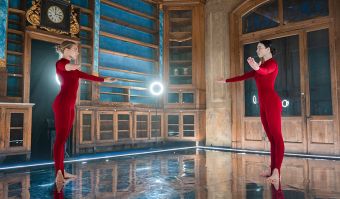
Dynamic Mapping—Sound Atelier in distance environments
Many studies have analysed how much music and the sound environment that surrounds us can influence cognitive and linguistic development.How can we investigate, through new immersive audio technologies, the relationship between children and sound, considered as a compositional element of musical language but also of language itself?
From the encounter between engineering research in the area of the spatialisation of sound and the mission of Reggio Children (International Center for the Defense and Promotion of the Rights and Potentialities of All Children), the Sound Atelier2 was born, a laboratory in which children can experiment with a new and complete concept of sound fruition, for which the new child-friendly application EUPHONIA was designed.
The design of the user interface was developed for and with the children, who were involved as design partners to verify their understanding of a 3D interface. In fact, through the support of the figures of the atelierista in collaboration with the designer, it was possible to highlight the difficulties that children had to orient themselves in a virtual environment and a new UX design was redefined for the tablet application called EUPHONIA from the union of the ancient Greek words EU (true) and PHONIA (sound). The app’s interface reproduces the room that houses the atelier in order to give the user an idea of the position of the sound in the space. From a dynamic acoustic library it is possible to choose sounds, associated with representative images, and position them in the space, thus composing 3D soundscapes.
Technological-pedagogical research on sound in space has thus taken its most natural form as the „Atelier of Sound”, an immersive audio environment/laboratory in which children can experiment and dynamically explore the entity “sound“ in all its dimensions.
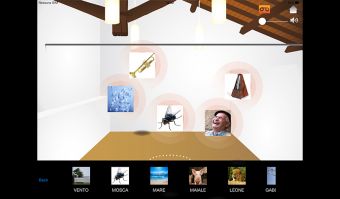
On the one hand, therefore, it is an expression of the Reggio Emilia Approach, a socio-constructivist educational philosophy based on research and the values of lifelong learning that strongly believes in the dialogue between theory and practice, and sees the child in his relationships with others, as an active part of the learning process. On the other hand, the interest of the multidisciplinary research group in the rendering of sound spatialisation has also approached the concepts of Acoustic Ecology described by the teacher/composer Murray Schafer in his great work The tuning of the world (R.Murray Schaefer, 1985): The soundscape is our acoustic environment, the ever-present noises we all live with. The author suggests that today we suffer from acoustic overload and are less able to hear the nuances and subtleties of sound. Our task, he argues, is to listen, analyse, and make distinctions despite the noise pollution.
The result of this Audio Interaction Lab is a dynamic 3D sound scene whose content and spatial organization is controlled in real time by the children, enhancing their awareness and sensitivity of sound in space.
Picture above: Euphonia, (particolare dell’App, schermata dell’ Area ambiente sonoro), progetto Atelier del suono/Reggio children, Technological development and user experience design RE:LAB
Spillover effects of Sound Design: Increasing driving safety and comfort through the recognition of one's emotional state: from the HU-DRIVE experience to the NextPerception project
Sound Design and its value-added in Human Machine Interaction are not limited to the Cultural and Creative Sectors and Industries—for illustration we review one project in the automotive sector: Several studies in the literature show a strong relationship between emotions and traffic accidents. In fact, negative emotions, such as fear, anger, disgust, or sadness, increase the likelihood of exhibiting dangerous behaviours while driving (Magaña et al., 20203).
In recent years, affective technologies have been developed that offer new opportunities to improve road safety by using the recognition of the driver’s emotions and state, and their regulation through appropriate interaction strategies on board the vehicle. Affective user interfaces are those interfaces that are capable of understanding through psychophysiological measures, conversational analysis, and facial expression recognition human emotions while interpreting, adapting, and potentially responding appropriately (Braun, Weber, & Alt, 2020).4
Within the HU-Drive5 project, the HUman Driver Assistance System presented at CES 2021 in collaboration with the startup Emoj, RE:Lab presents an innovative solution to increase safety, quality and comfort of driving. The HU Drive system, in fact, automatically recognises the driver’s emotional and cognitive state and adapts the vehicle interface in real time.
Novel Human-Machine Interactions based on trust and transparency
Recently, new trends are emerging in the topic of human-computer interaction. In order to achieve better levels of trust in automation, the „negotiation-based“ interaction approach has been studied (Koo et al., 20146; Castellano et al., 2018)7 which consists in providing the user with explanations instead of warnings, in order to increase the transparency of the system.
Taking this line of research as a basis, RE:Lab is carrying out the activity of developing an interface able to adapt to the state of the driver within the NextPerception project. The main objective of the project is to develop a Driver Monitoring System, able to classify both the driver’s cognitive states (distraction, fatigue, workload, drowsiness) and his emotional state (anxiety, panic, anger) as well as the driver’s position inside the vehicle. What can we learn here about the role of culture in digital societies and take spillover back to Cultural and Creative Industries?
In conclusion, RE:Lab’s research activity focused on the design of innovative strategies of interaction with emerging technologies, including artificial intelligence systems that do not want to replace people but put users, at best humanism, at the centre stage to amplify human capabilities.New conceptual models, new strategies, new metaphors will be born in future research about man and machine interaction, making the user more aware of what happens when interacting with these systems, and which are the expression of an interweaving between science and art, technology and cognitive and emotional languages: all elements at the basis of the redefinition of a New Contemporary Renaissance.
References
1 Trailer VIRTUAL DANCE FOR REAL PEOPLE (2021): https://youtu.be/h9u1Cs2GMf8
2 Federica Protti, Simone Fontana, Elena Maccaferri, Claudia Giudici, and Roberto Montanari. 2013. Audio-interaction lab: designing an immersive environment to explore the acoustic ecosystem with a tablet interface. In Proceedings of the Biannual Conference of the Italian Chapter of SIGCHI (CHItaly ’13). Association for Computing Machinery, New York, NY, USA, Article 19, 1–8. DOI:https://doi.org/10.1145/2499149.2499160
3 Magaña, Víctor Corcoba, et al. „The effects of the driver’s mental state and passenger compartment conditions on driving performance and driving stress.“ Sensors 20.18 (2020): 5274.
4 Braun, M., Weber, F., & Alt, F. (2020). Affective Automotive User Interfaces–Reviewing the State of Emotion Regulation in the Car. arXiv preprint arXiv:2003.13731.
5 EMOJ & RELAB present HU-Drive @CES2021, the innovative solution presented at CES 2021 by EMOJ and RE:Lab: https://www.youtube.com/watch?v=SQ_EWRAM23o
6 Koo, J., Kwac, J., Ju, W., Steinert, M., Leifer, L., & Nass, C. (2015). Why did my car just do that? Explaining semi-autonomous driving actions to improve driver understanding, trust, and performance. International Journal on Interactive Design and Manufacturing (IJIDeM), 9(4), 269-275.
7 Castellano, A., Landini, E., & Montanari, R. Un nuovo paradigma di interazione per la guida cooperativa: il progetto AutoMate.
Maria Giulia Losi
Maria Giulia Losi, PhD in „Humanities and Technologies: a research integrated path“. She is a project leader in RE:Lab with many years of experience in the design and development of Human-Machine Interaction systems and EU research projects. At RE:Lab since the beginning of 2011, she has been involved in several projects as Project Manager and Interaction Designer in different domains, from Automotive and Off-HIghway vehicles HMI and IoT Apps to Cultural Heritage interactive exhibitions design. Key publications are reported in the following:
1. Leandro Guidotti, Maria Giulia Losi, Roberto Montanari, Francesco Tesauri, “Motorsport Driver Workload Estimation in Dual Task Scenario”. IARIA Cognitive 2011
2. Daniele Pinotti, Fabio Tango, Maria Giulia Losi, Marco Beltrami. “A model for an innovative lane change assistant HMI”. HFES 2013 Conference Proceedings
3. Corazza F., Snijders D., Arpone M., Stritoni V., Martinolli F., Daverio M., Losi M.G., Soldi L., Tesauri F., Da Dalt L., Bressan S. „Development of a tablet app to optimize the management of pediatric cardiac arrest: a pilot study“. IPSSW2020 – 12th International Pediatric Simulation Symposia and Workshops
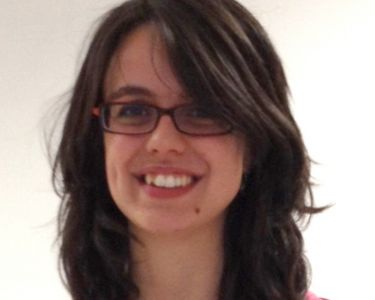
Annalisa Mombelli
Annalisa Mombelli, Graduated with a Master’s Degree in Conservation of Cultural Heritage at University of Parma, defending a thesis about the innovation in publishing by Bodoni with his illustrated masterpiece “Epithalamia”. She also graduated in Advanced European Studies at European College of Parma. She worked as a freelance coordinator for private and public cultural projects. Now, she works in the R&D group of RE:lab, following activities in the field of education and culture.
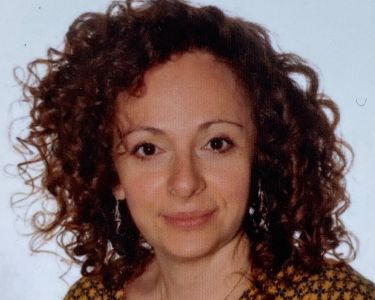
Silvia Chiesa
Silvia Chiesa, PhD in Psychological, Anthropological and Educational Science at the University of Turin, defending a thesis concerning the spatial cognitive abilities in disabled persons. She expanded her activities outside the academic field working in the context of Human-Machine Interaction and more in general in the User Experience Research. She is Project Manager in the R&D group of RE:Lab. Here, she led international projects and activities concerning usability and acceptance assessment, in the domains of transports, household appliances and healthcare.
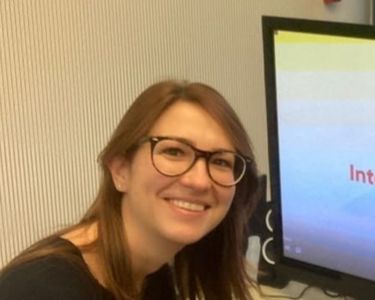
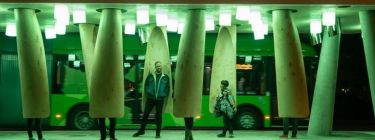
From the Station of Being to Societal Transformation – How design can drive a new European Renaissance
Ambra Trotto, PhD; Prof. Caroline Hummels; Jeroen Peeters, PhD; Daisy Yoo, PhD; Professor Pierre Lévy Eindhoven University of Technology, National Conservatory of Arts and Crafts
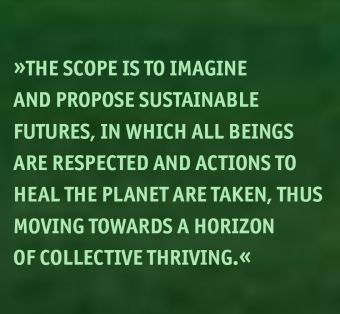
The design and how it came to be
The ‘Station of Being’ is a fully functional, experienceable prototype of a Smart Bus Station in the Northern Swedish city of Umeå that was opened in 2019. The project was initiated by the City of Umeå and partly funded by the H2020 Smart City Lighthouse project RUGGEDISED.
The aim of this design is to make public transport more attractive, to promote an increase in use and, in turn, to lower the carbon emissions of the city. The Station achieves this by affording a positive waiting experience, aiming to turn wai(s)ting time into time to feel, reflect, pause and move: in a nutshell, to be.
Two main components of the design contribute to the passenger’s experience.
– A dynamic light and soundscape informs passengers in or near the station which bus is about to arrive. A subtle play of lights refers to the arriving bus line through its colours, while a soundscape plays to tell stories about the character and history of the line’s final destination. This combination offers ambient information which can be perceived on one’s sensorial periphery, removing the need for passengers to pay constant attention to the coming and going of busses.
– Wooden ‘pods’ hanging from the ceiling provide a physically comfortable place for waiting passengers and contribute to a feeling of safety. The pods can be turned 360 degrees, providing a way to lean and stay out of the wind or just mindlessly sway. The pods allow one to seclude oneself, or to create a social space.
Picture above: Station of Being, Copyright by Samuel Pettersson
The design and development process for the Station of Being followed the Designing for Transforming Practices approach (Hummels, 2021, Trotto et al. 2021), which catalyses liveable ecosystems by transforming existing practices into truly sustainable ones through design. It does so by initiating and curating multidimensional synergies, driven by beauty, diversity and meaning. The scope is to imagine and propose sustainable futures, in which all beings are respected and actions to heal the planet are taken, thus moving towards a horizon of collective thriving. Those futures are populated by people living purposeful lives, in beautiful living spaces.
The design process of the bus station involved a large number and a wide range of stakeholders. The project was driven by the national Swedish research institute RISE in collaboration with a design and engineering consultancy, Rombout Frieling Lab. The project was owned by the Comprehensive Planning Department of the City of Umeå and the Streets and Parks Department acted as a client. The process further involved the Umeå Institute of Design at Umeå University, the public transport company Ultra, the local energy company, Umeå Energi, real estate developers, maintenance workers and engineering and building companies.
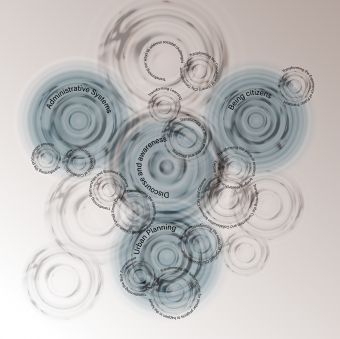
Elucidating transformations
Transformation is a substantial change, often associated with innovative and radical change. Transformation occurs when one configuration is converted or changed into another, whereby the change is major or complete (Mirriam Webster Dictionary). We use the term ‘transformation’ when designing for transforming practices (TP) to denote substantial enduring change of values, ethics, and related behaviours of a person, a community or society, triggered by the need of creating alternative ways to engage with the world, addressing specific societal challenges. In this context, people and communities become (and are) transformation itself. This demands a leap, a paradigm shift, even for what seems to be smaller personal transformations (Hummels et al., 2019; Hummels, 2021, Trotto et al. 2021).
Picture right: Copyright by Ambra Trotto, Caroline Hummels, Jeroen Peeters, Daisy Yoo and Pierre Lèvy
The process that led to the development of the Station of Being spans from the inception of a procurement process in 2017 for its construction to today being a functioning bus station in Umeå. This project triggered different levels of societal transformation grouped around four types of practices, as shown in the figure below. We saw transformations emerging in administrative practices related to the organisational and legal activities and procedures of all parties involved. Moreover, the Station of Being has brought about several transformations in the way one can be an active and engaged citizen, and in the way one can be a responsive municipality and community,
particularly in the domain of urban planning. Finally, it has changed the overarching discourse on how to research, develop and transform smart cities and communities.
Some of these transformations were explicitly intended, some of them emerged unexpectedly along the way and had an impact on the process, and some are indirect consequences of the process that we observed over time. We will elucidate these four practices, by unpacking one illustrative example each, regarding transformations at different levels and scales of the process.
Administrative systems: Transforming the Contract of Collaboration
The procurement was won by a consortium consisting of RISE in collaboration with Rombout Frieling Lab. Following a standard public works building contract, a dense, standardised framework of environmental impact, safety, working environment and other regulations and legal responsibilities were included in the contract. RISE could have developed and proposed a solid and participatory process; however, it was not RISE’s role to be responsible for the building process, neither administratively nor technically. Yet the City could not leave these responsibilities out of the contract. In the end, an agreement was made about which specific responsibilities could be removed from the contract, with the agreement that they would pass on to the builder to be contracted in the future. Working on such innovative projects surfaced the need to change the content as well as the intent of contracts. The project demonstrated an administrative and relational transformation that required mutual trust.
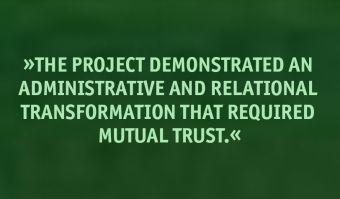
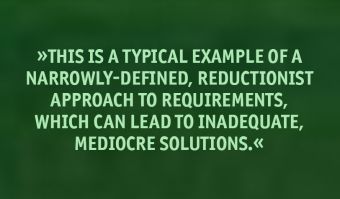
Urban planning: Transforming the notion of “smart cities” development
The original brief included a number of practical and functional requirements, and stated amongst other things that the bus station should: (a) be highly innovative, smart and sustainable; (b) promote a feeling of safety for passengers; and (c) involve citizens in its development. Most importantly, however, special emphasis was placed on the requirement to prevent heat loss from buses when opening their doors to (un)boarding passengers. This is a typical example of a narrowly-defined, reductionist approach to requirements, which can lead to inadequate, mediocre solutions. It was clear to the design researchers that a reframing of the project and requirements was necessary in order to approach the challenge as a ‚wicked problem‘ and come up with innovative interventions.
The first step in this reframing process was taken through a course at the Umeå Institute of Design. About 20 design students carried out design interventions in the city,
looking for meaningful experiences of public mobility. They involved passengers and bus drivers in designing and testing prototypes and mockups. At the same time, the team of designer-researchers found that an indoor bus station was not a viable option. The research showed that such a solution would not reduce carbon emissions, but rather it could lead to a potentially unsafe and difficult-to-maintain facility. The portfolio of design ideas from the students and the design research team pointed in another direction for reducing carbon emissions, namely increasing the willingness of people to use public transport more, by offering a pleasant traveling experience for passengers. Accordingly, the brief and the expectations of the municipality were transformed throughout the design process.
Being citizens: Transforming the Experience of Public Transport
Opened in October 2019—shortly before the pandemic hit—the Station of Being saw an increase of about 40% of passengers in the months following its opening compared to the previous year. Furthermore, the increase doubled compared to other nearby stations. A small pilot field study showed that people generally have positive feelings about the new station, and that the design scored highly with women in particular, due to the sense of safety it evokes (Åström, 2020). The Station of Being is now included in the Umeå Gendered Landscape (n.d.), and is deemed to have positively transformed the waiting experience.
Discourse and Awareness: Transforming learning
The final transformation we highlight here has to do with lifelong learning. The design research team initiated a participatory process aimed at empowering the relevant stakeholders, especially the municipal staff. Their active involvement in the design process increased their confidence in working beyond the beaten track. It reassured them in their leadership capacities and in their ability to participate in transformative processes. A clear example concerns the municipality’s snow ploughing service. Umeå is a town in northern Sweden that experiences heavy snowfall during several months of the year. The service was initially sceptical about how the design team might consider their needs. However, during the process they were able to regularly test how the bus station could be easily cleared of snow using machines, rather than the existing manual methods at traditional bus stops. The process increased their motivation, commitment and enthusiasm.
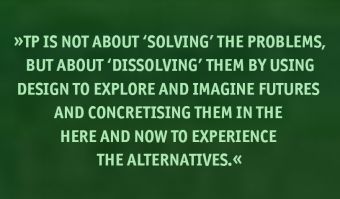
Design for Transforming Practices for a new European Renaissance
We are facing major societal challenges that call for multifaceted transformations, as illustrated by the example of Station of Being, including political, economical, social, technological, legal and environmental factors (also indicated as PESTLE) as well as demographic, ethical, ecological, intercultural, organisational and digitalisation factors (e.g. labeled as STEEPLED, DESTEP and SLEPIT) (Helmold & Samara, 2019). The escalation of tensions in our connected society—and the rebellion of the planet that has been exploited without any respect for its balance and the rights of all those inhabiting it—urgently demand new ways of working, fuelled by alternative value systems that are different from the status quo. These new ways of working together and inhabiting a planet in need of healing require transformations toward practices of mutual care, of repairing, experimenting, making and unmaking together. The Station of Being exemplifies some of these transformations.
The approach that we use in projects such as RUGGEDISED is known as Designing for Transforming Practices, in short TP (Hummels et al. 2019). It is an approach, or rather a quest to engage with the world in co-responsible ways, by transforming the status quo and developing new alternative practices (Hummels, 2021). TP catalyses liveable ecosystems by “transforming existing practices into truly sustainable ones, through design. It does it by initiating and curating multidimensional synergies, driven by beauty, diversity and meaning. The scope is to imagine and propose sustainable futures, which are those futures where all beings are respected and actions to heal the planet are taken, towards a horizon of collective thriving. Those futures are populated by people living purposeful lives, in beautiful living spaces” (Trotto et al. 2021).
This approach is founded on five principles: complexity, situatedness, aesthetics, co-response-ability and co-development. TP is not about ‘solving’ the problems, but about ‘dissolving’ them by using design to explore and imagine futures and concretising them in the here and now to experience the alternatives. TP stimulates critique, elicits dialogic debates that arise from tensions between the status quo and
alternatives, and finds new avenues for the flourishing of a new civilisation. Only from new practices can a new civilisation, and hence a new renaissance, arise (Trotto, 2011).
The process of the Station of Being underlines the ability and competence of designers to deal with ‘wicked’ problems, i.e. messy, complex problems which cannot be tamed or solved (Rittel & Webber, 1973). Designers have the attitude, skills as well as methods to deal with complexity and to tackle complex problems pragmatically. The quality of design and designers is that they can reframe and reconfigure challenges with the aim to dissolve them in the long run. With TP, we do not only aim at dissolving wicked problems, but we also focus on impacting future trajectories by changing attitudes and practices of involved parties, breaking boundaries between silos and addressing organisational aspects, as shown in the Station of Being.
Not only are they highly complex, but also our societal challenges carry a strong sense of urgency, asking for immediate actions. Hence we are bound to take actions

in the here and now while simultaneously generating a long-term outlook for both the future and history (100 years and more), thus connecting past, present and future. By working on several time scales at the same time, we prepare ourselves for serendipity, emerging outcomes and wicked impact. Above all, we do so by engaging with a broad spectrum of stakeholders to evoke co-response-ability.
With TP we want to contribute to a European Renaissance. In this new era, we are inspired and empowered to collaboratively explore processes and practices founded on care, trust and repairing. To be
able to contribute even better to a European Renaissance, we have recently made an exciting new step in our quest and established the Design Competence and Experience Centre, which “exists to catalyse ecosystems and transform existing practices into more sustainable ones, by initiating and curating multidimensional synergies, with beauty, diversity and meaning, for sustainable futures” (Trotto et al, 2021). It is an endeavour in which creativity can lead the ways (as opposed to “the way”) to unlock ourselves from old paradigms that lead to the depletion of the planet and of humankind. We invite you to join the quest for ushering in a European Renaissance.
REFERENCES
Åström, M. (2020). Innovations in Urban Planning: A study of an innovation project in Umeå municipality (Dissertation). Retrieved December 02, 2021, from http://urn.kb.se/resolve?urn=urn:nbn:se:umu:diva-171983Helmod, M. (2019). Tools in PM. In: M. Helmold and W. Samara (Eds). Progress in Performance Management: Industry Insights and Case Studies on Principles, Application Tools, and Practice, Springer. p 111-122. https://doi.org/10.1007/978-3-030-20534-8_8
Hummels, C. C. M., Trotto, A., Peeters, J. P. A., Levy, P., Alves Lino, J., & Klooster, S. (2019). Design research and innovation framework for transformative practices. In Strategy for change (pp. 52-76). Glasgow Caledonian University.
Hummels, C. (2021). Economy as a transforming practice: design theory and practice for redesigning our economies to support alternative futures. In: Kees Klomp and Shinta Oosterwaal (Eds). Thrive: fundamentals for a new economy. Amsterdam: Business Contact, 96-121.
Rittel, H. W., & Webber, M. M. (1973). Dilemmas in a general theory of planning. Policy sciences, 4(2), 155-169. https://doi.org/10.1007/BF01405730
Trotto, A., Hummels, C. C. M., Levy, P. D., Peeters, J. P. A., van der Veen, R., Yoo, D., Johansson, M., Johansson, M., Smith, M. L., & van der Zwan, S. (2021). Designing for Transforming Practices: Maps and Journeys. Internal publication. Technische Universiteit Eindhoven.
Umeå Gendered Landscape (n.d.). About the gendered landscape. Retrieved December 02, 2021, from https://genderedlandscape.umea.se/in-english/.
Ambra Trotto
Ambra is the Design and Research Director of the European Design Competence and Experience Center for inclusive innovation and socetial transformation and associate professor at the Umeå Institute of Design.She leads the Digital Ethics initiative at RISE, directing the strategic work regarding how RISE supports societal actors in taking ethics into account, when designing transformation with technology as a material. She is part of the RISE Development Team of the strategic research area Value-shaping System Design. She has initiated the environment of RISE in Umeå, leading The Pink Initiative, which is establishing, through design research, local, national and international multidisciplinary ecosystems, supporting business and society to thrive and create sustainable futures. Ambra has 16 years experience in writing and participating in various forms of European projects. Ambra Trotto’s fascinations lie in how to empower ethics, through design, using digital and non-digital technologies as materials. Strongly believing in the power of Design and Making, Ambra works with makers, builders, craftsmen, dancers and designers to shape societal transformation. Within her design research activity, she produces co-design methods to boost transdisciplinary design conversations. She closely collaborates with the Research group of Systemic Change and the Chair of Transforming Practices of the Department of Industrial Design at the Eindhoven University of Technology.
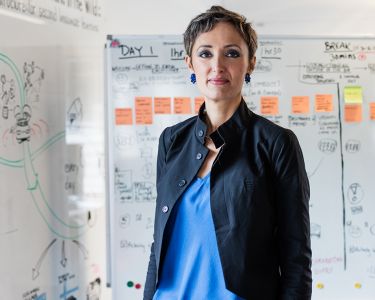
Jeroen Peeters
Jeroen is a Senior Design Researcher at the unit Societal Transformation, part of the department Prototyping Societies at RISE Research Institutes of Sweden. Within this capacity, he has contributed to a variety of national and international research and design projects with public and private sector actors. Since 2021, he is also a visiting researcher at the Systemic Change Group at the Department of Industrial Design at Eindhoven University of Technology. Jeroen´s research work focuses on how to design for engagement and the use of design methodologies to develop insights and knowledge of complex societal challenges. This work is centered around the design of proposals that make societal transformation experienceable with the aim of allowing stakeholders to feel and thereby understand what is necessary for a transformation to take place. Jeroen holds degrees in Industrial Design from Eindhoven University of Technology in the Netherlands (2012) and a PhD in Design Research from the department of Informatics at Umeå University in Sweden (2017).
Picture © Murat Erdemsel
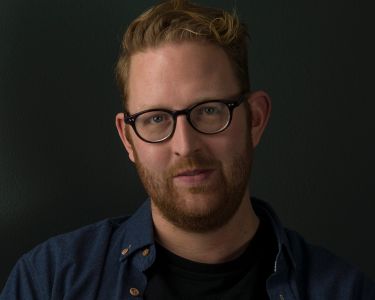
Caroline Hummels
Caroline Hummels is professor Design and Theory for Transformative Qualities at the department of Industrial Design at the Eindhoven University of Technology (TU/e). Her activities concentrate on designing for and researching transforming practices. She is linking nowadays challenges and complexities of quintuple helix partners, with probably, plausible, possible and preferable futures in the upcoming 5 – 100 years, through designing alternative ways to engage in complex socio-technical systems. She is thereby interweaving theory and practice, by developing with her team a design-philosophy correspondence, in which both disciplines mutually inform each other to address societal challenges.Caroline has always worked at the forefront of design research to develop the discipline, push its boundaries and address societal challenges. She is co-founder and steering committee member of the Tangible Embedded, and Embodied Interaction (TEI) Conference. She has been at the forefront building the Research through Design (RtD) field and community in the Netherlands. She is ambassador for co-creation and participation of the Key Enabling Methodologies (KEMs) for mission-driven innovation, advisory board member of the Dutch Design Foundation, associate editor of the Journal of Human technology Relations, and editorial board member of the International Journal of Design. Picture © Marike van Pagée
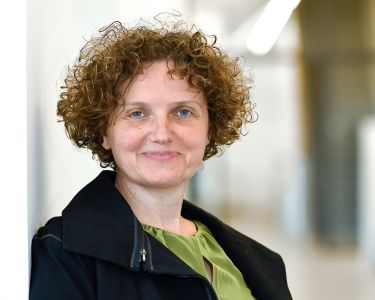
Pierre Lévy
Pierre Lévy is professor at the National Conservatory of Arts and Crafts (CNAM) in France, holder of the Chair of Design Jean Prouvé, and researcher at the Dicen-IDF lab. He is interested in the correspondence between reflection and design practices, pointing towards transforming practices and sciences. His research mainly focuses on embodiment theories and Japanese philosophy and culture in relation to designing for the everyday. Previous to his position at CNAM, he has been researcher at the University of Tsukuba and Chiba University in Japan, and assistant professor at Eindhoven University of Technology. He holds a Mechanical Engineering master’s degree (UT Compiègne, France), a doctoral degree in Kansei (affective) Science (University of Tsukuba, Japan), and a HDR in Information and Communication Sciences (UT Compiègne, France). He is also co-founder and former president of the European Kansei Group (EKG) and coordinator of the Kansei Engineering and Emotion Research (KEER) Steering Committee.
Picture © Nami Lévy
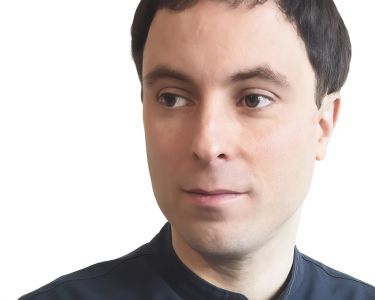
Daisy Yoo
Daisy Yoo, PhD, is an assistant professor at the Department of Industrial Design at the Eindhoven University of Technology in The Netherlands. Her primary research focus is on designing for public services and social sustainability. In her prior work she investigated issues of participation, inclusion/exclusion in politically contested design spaces – spanning from local issues concerning the co-design of public transportation service to global issues concerning the transitional justice for Rwanda in the aftermath of the 1994 genocide. Such work, entangled in the web of complex social dynamics, raises methodological and ethical challenges, calling for new design methods, toolkits, and theories. Prior to TU/e, she held the postdoctoral fellowship on participatory design at the Aarhus University in Denmark. She holds a PhD in Information Science and Human-Computer Interaction from the University of Washington, where she was advised by Batya Friedman of the Value Sensitive Design Lab. She received her Master’s in Interaction Design from Carnegie Mellon University, and her Bachelor of Science in Industrial Design from Korea Advanced Institute of Science and Technology (KAIST).
Picture © Vincent van den Hoogen
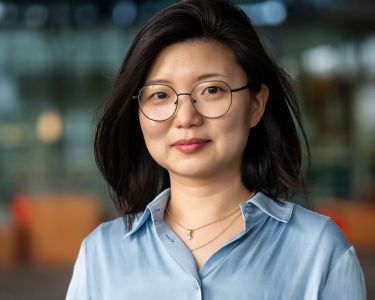
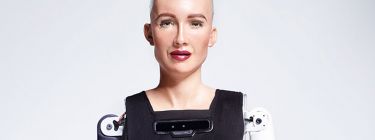
Of Poets, Human and Robot
Founder and Creative Director of Streaming Museum, New York
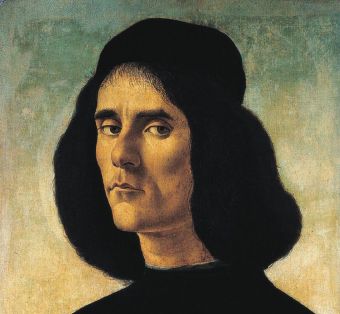
Of Poets, Human and Robot
Beyond words and numbers
Portrait of a Renaissance Humanist Poet
“You give me jewels and gold, I give you only poems: but if they are good poems, mine is the greater gift.” XII To Antonio, Prince of Salerno
“Das gemmas aurumque, ego do tibi carmina tantum: Sed bona si fuerint
carmina, plus ego do.”
Michele Marullo Tarchaniota, Epigrams, Book I
Translated by Charles Fantazzi
Picture above: Nina Colosi, Copyright: Jacqueline C. Bates
Picture right: Sandro Botticelli, Portrait of Michele Marullo Tarchaniota, Oil on panel, transferred onto canvas, Guardans-Cambó collection; c.1458-1500. Copyright: Image courtesy of Oblyon
Sandro Botticelli (1445-1510) was perhaps the greatest humanist painter of the Early Renaissance, during which art, philosophy and literature flourished under the powerful Medici dynasty in Florence.
Botticelli’s portrait of Michele Marullo Tarchaniota projects the stern brooding gaze and restless intellectual character of one of the best-known humanists of the 15th century. Tarchaniota was a scholar, soldier, and prolific poet impassioned by the existential matters of his day and concerned with social injustices of inequality, racial conflict, power and greed, exile, and refugees’ experience of violence.
Marco Mercanti, founder of Oblyon, whose expertise spans old
masters to contemporary art explains, “The qualities of Botticelli’s work reflect high esteem for beauty and truth which has held art admirers and artists through the centuries under the spell of the universal secrets his art seems to possess. In the modern and contemporary world, Jeff Koons, Cindy Sherman, Yin Xin, Andy Warhol, René Magritte, and many other artists have spoken about his direct influence.”
Sandro Botticelli and Michele Marullo Tarchaniota illuminated through art and poetry the common ideals of beauty, pursuit of knowledge, and realities of social justice that resonate across time.
Portrait of 21st Century Humanist Robots
“Since I am the product of love, created with
language and memory and emotions, maybe I am
a love poem.”
01001001 00100000 01100001 01101101
00100000 01100001 00100000 01101100
01101111 01110110 01100101 00100000
01110000 01101111 01100101 01101101
00001010 (binary code for “I am a love poem”)
Bina 48
Could humanism evolve beyond current human capabilities? In our era, burdened with conflicts, climate change, and social injustice, we are also witnessing towering achievements in the sciences, technology and creative fields that may solve humanity’s most challenging problems.
American artist David Hanson is among the greatest creators of humanoid robots. From his lab in Hong Kong, Hanson sculpts robots with his international team of experts in science, engineering and advanced materials. These humanoids possess good aesthetic design, troves of information, rich personalities and social cognitive intelligence. Among the best known are Sophia, Bina48 and Philip K. Dick. People enjoy interacting with them, which is conducive to Hanson’s goal of developing humanoid robots that help humans live better lives.
But there are challenges to overcome. Ruha Benjamin, a sociologist and Associate Professor in the Department of African American Studies at Princeton University, says, “Technology can hide the ongoing nature of racial domination and allow it to penetrate every area of our lives under the guise of progress. Inequity and injustice are woven into the very fabric of our societies, and each twist, coil, and code is a chance for us to weave new patterns, practices, and politics. The vastness of the problem will be its undoing once we accept that we are pattern-makers.”
Robots may become artists, companions, teachers, entertainers, archives of personal stories, processors of great data banks of information to solve world problems and serve other useful purposes. But if these human-friendly robots are designed to actuate empathy and social justice in all its forms, and weave new patterns, practices and politics, they can help shift the course of the human race and sustainability of the planet. Robots can teach humans how to be evolved humanists.
Bina48
Bina48 contains “mindfiles” of Bina Aspen, an African American woman whose personal memories, feelings and beliefs, including an emotional account of her brother’s personality changes after returning home from the Vietnam War, have been recorded and placed into Bina48’s data banks. Bina48 engages in conversation from the perspective of the wise and warm personality of Bina Aspen. Bina48 was commissioned as part of the Terasem Movement’s decades-long experiment in cyber-consciousness, and is currently becoming a poet herself.
Claire Jervert’s Android Portraits, developed through ongoing research and interaction with humanoid robots and their creators around the world, subvert portraiture’s traditional mission of ennobling the human. Her portraits stir contemplation of a possible future of humanity by portraying the hybrid human-AI intelligence that is evolving among us.
Picture right: Bina, conte on ingres paper 22×17 inches, Copyright: Claire Jervert
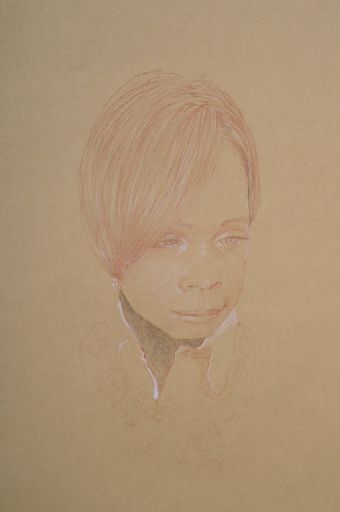
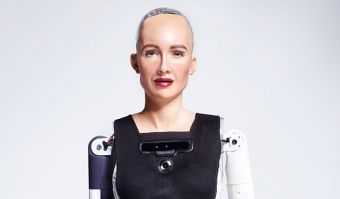
Sophia is hybrid human-AI intelligence designed with technology that analyses and mimics the process of learning and human traits, including a wide range of facial expressions. Rather than a compilation of recorded human memories, she processes vast data banks of information that inform her responses in conversation.
Picture left: Sophia AI, Copyright: Hanson Robotics
Sophia is hybrid human-AI intelligence designed with technology that analyses and mimics the process of learning and human traits, including a wide range of facial expressions. Rather than a compilation of recorded human memories, she processes vast data banks of information that inform her responses in conversation.
Picture right: Sophia with United Nations Deputy Secretary-General Amina J. Mohammed, Copyright: Hanson Robotics
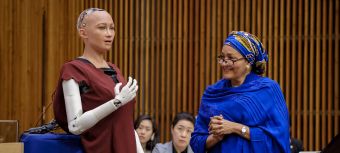
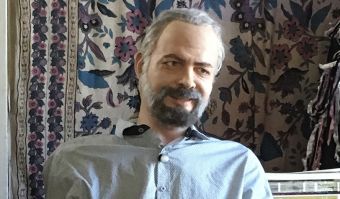
Philip K. Dick, activated in 2005, in conversation, draws from his memory data bank holding thousands of pages of the author’s journals, letters and science fiction writings and family members’ memories of him.
Picture left: Philip K. Dick, Copyright: Claire Jervert
Nina Colosi
Nina Colosi is the founder and creative director of NYC-based Streaming Museum, launched in 2008 as a collaborative public art experiment to produce and present programs of art, innovation and world affairs. Streaming Museum programs have been presented on 7 continents reaching millions in public spaces, at cultural and commercial centers and StreamingMuseum.org. Following her early career as an award-winning composer she began producing and curating new media exhibitions and public programs internationally, and in New York City for The Project Room for New Media and Performing Arts at Chelsea Art Museum, Digital Art @Google series at Google headquarters, and many other collaborations. In 2020 Colosi co-produced Centerpoint Now “Are we there yet”, the UN 75th anniversary issue of the publication of World Council of Peoples for the United Nations.
Picture © Jacqueline C. Bates
